- Movies & TV
- Big on the Internet
- About Us & Contact
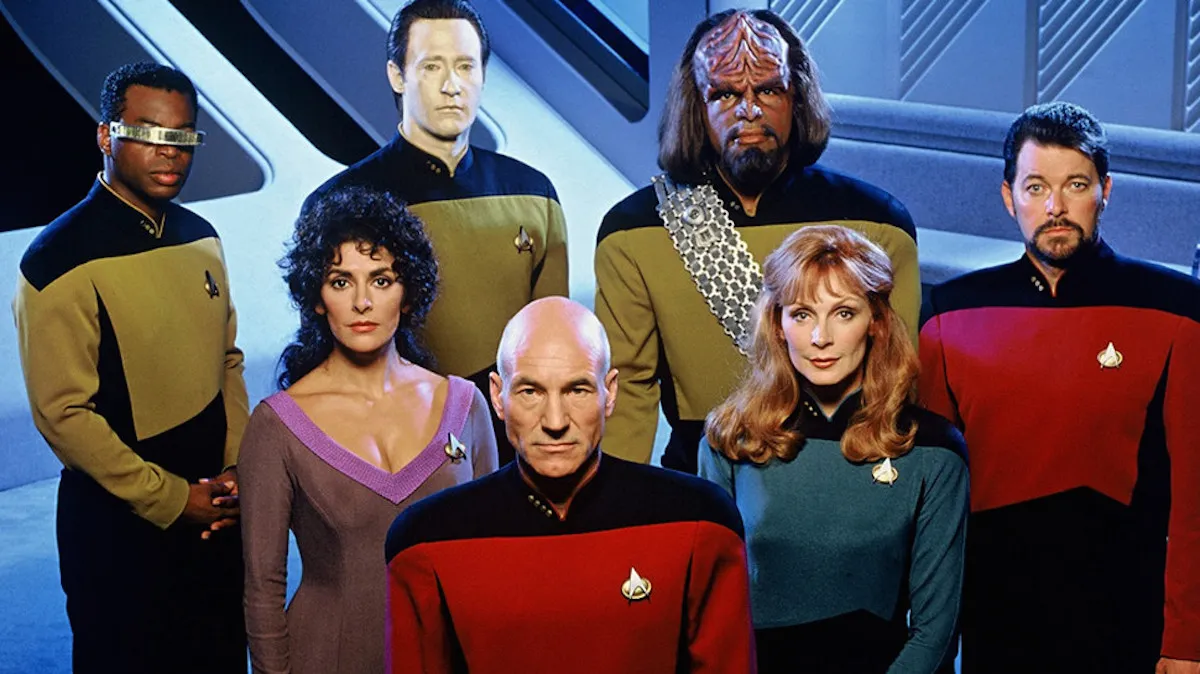

A Guide to the Different Uniform Colors the Characters Wear in ‘Star Trek’
Star Trek: The Original Series premiered in 1966. And in the year 2022, the franchise doesn’t seem to be slowing down soon. Currently, there are several ongoing television series with a new film and series recently announced.
I was a toddler when Star Trek: The Next Generation came out in 1987, making Picard’s Enterprise crew one of my earliest memories. I still love the series (as I sip out of my Chateau Picard wine tumbler). But the meaning of their uniform shirts eluded me for the longest time. Honestly, I thought you just picked your favorite color outfit when you joined a crew. After the “redshirt” trope (where a redshirt team member was more likely to die on a Star Trek away mission) became known, I thought there might be more to it. Apparently, there is a whole color-coded system in place. And the meaning of the colors changed slightly through the various shows.
The Original Series
For the original Star Trek series and the Enterprise prequel that came later, the uniform color breakdowns are:
Red – Engineering, Security, and Communications
Blue – Science and Medical Staff
Gold – Command Staff
Green – Command Staff Formal
The original series is where the redshirt trope comes from. It always seemed like if a random character in a red shirt went on an away mission, then they were not making it back to the ship. The largest group of people wore red uniform shirts, which would make it more likely that a person who died or got injured would have a red shirt on.
The Next Generation
When The Next Generation arrived, the series changed several things from the original, including the uniform colors:
Red – Command Staff
Gold – Operations and Security Staff
TNG , more so than the original series, set the template for most future shows. Even though the uniform styles changed, the color classifications stayed the same in Deep Space Nine , Voyager , Discovery , Picard , and the animated show Below Decks .
However, every season contained at least one character who wore their own take on the uniform that did not line up with the standard Starfleet look. Examples being: Deanna Troi from TNG (to relate to her patients better), Odo and Kira Nerys from Deep Space Nine (because of their connection to the Bajoran military), and Seven of Nine in Voyager (because of her cyborg physiology).
Now that we are clear on which uniform color means what, which color would you pick?
(feature image: Paramount)
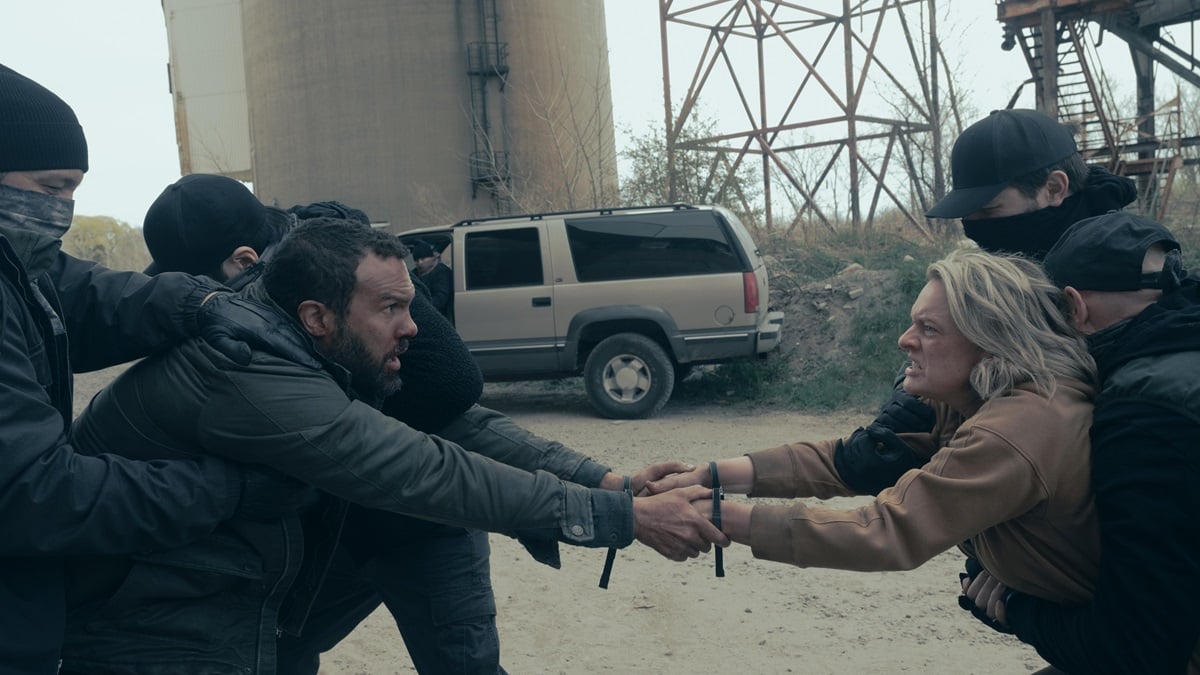
What Do the Different Uniform Colors Mean on ‘Star Trek’?
By jason serafino | mar 30, 2023, 3:23 pm edt.
Gene Roddenberry may have dreamed of a perfect future when he created Star Trek , but parts of his vision were firmly rooted in the real world, specifically in the physical makeup of the crew of the Enterprise itself.
Roddenberry, along with the show’s producers, decided to take numerous cues from the United States Navy when creating the official ranks on the show, including a captain overseeing a crew made up of a commander, a handful of lieutenant commanders, lieutenants, and several subordinate roles. But it’s the different colors of the Starfleet uniforms that really tell the story of how the Enterprise operates.
Fans know the basics: an array of blue, red, and gold shirts line the bridge of the ship every episode. Those colors weren’t just randomly picked for the sake of diversity, though. They actually correspond to the ship’s various service roles . The gold shirts are worn by the command division, which includes Captain Kirk, Lieutenant Sulu, and Pavel Chekov. Red uniforms belong to the engineering/communications division, including chief engineer Scotty and communications officer Uhura. The blue shirts are worn by the science/medical staff, including McCoy and Spock .
As with everything in Star Trek , though, it’s a lot more complicated than all of that. In addition to the red shirts belonging to engineers and communications personnel, they are also assigned to the security division. What’s the purpose of the security division on the Enterprise ? Well, they’re usually the supporting characters who are immediately killed whenever the crew is confronted by a new enemy. This is something of a running gag for fans of the franchise, as whenever one of the “Red Shirts” is seen on screen, you know they’re not long for this world .
Also, those gold shirts worn by Kirk and crew might not have been so gold after all. According to an interview with Star Trek ’s costume designer, William Theiss, the idea was for the show’s uniforms to be red, blue, and green. In fact, on the set, Kirk’s outfit certainly looked to be an avocado (or lime) green, but the end result was a little different when the studio lights finally hit the uniform.
“It was one of those film stock things,” Theiss said, “it photographed one way—burnt orange or a gold. But in reality was another; the command shirts were definitely green.”
This might come as a surprise to Trek fans until you remember that Kirk actually did wear green on a few occasions, including the times he was in formal dress and his seldom-seen alternate green get-up, seen in the clip below.
These alternate uniforms were all the exact shade of green Theiss describes, but they were made from a different material than the standard Enterprise shirts and apparently had no issue retaining their natural color scheme when lit on set. The gold shade may have been a production mishap, but the color has since entered the Trek canon as the official hue of Kirk and his command staff. So, in the Star Trek universe, Kirk wears gold; in the real world, though, the bridge of the Enterprise was designed with a completely different color palette in mind.
It gets more confusing when you look at the later Trek series, like The Next Generation , which had the command staff in red and operations in yellow—basically the reverse of the original series. Then, of course, the movies switched costumes and colors with nearly every entry, including the powder blue monstrosities worn in Star Trek: The Motion Picture .
Roddenberry’s eye for detail was unique for sci-fi TV at the time, and everything on the Enterprise had a specific purpose. Despite some production fumbles, ill-fated redesigns, and inconsistencies later on, the colors that make up Starfleet’s uniforms tell a story that many viewers probably never even noticed.
A version of this story originally ran in 2016; it has been updated for 2023.
What Do The Star Trek Uniform Colors Mean & Why Are They So Important?
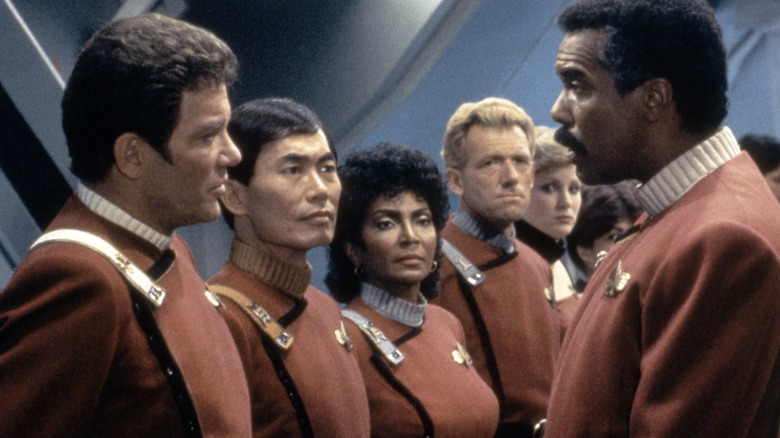
"Star Trek" is definitely a technicolor wonderland of a show. That sense of eye-catching brilliance trickles down from the background scenery to the props used by each cast member, all the way to the uniforms the show's central crew wears as a part of their duties.
It's easy to notice that the crew of the Starship Enterprise wear tunics in varying shades. Those colors are quite important — they denote which job class each crew member belongs to. Those classes were devised by series creator Gene Roddenberry and costume designer William Ware Theiss, and are intended to resemble the classifications used by the United States Military on noise-heavy aircraft carriers.
Sometimes there are differences allowed for dress uniforms; the command staff, for instance, will wear green uniforms during formal occasions. And these rules aren't hard and fast ones; across the whole universe of "Star Trek" series, films, and other ephemera, the colors various officers wear on the show and the meanings behind them change depending on when the scene takes place in the show's general timeline. But these are the color codes that most often denote each character's job on the ship, and the ones used during the original "Star Trek" series to explain who is who and what they do.
The term 'red shirt' gained a negative connotation
Even if you're not a "Star Trek" fan, you've probably heard jokes about how often red-shirted officers are introduced to the show, only for them to quickly die during away missions. For a period of time, the term "red shirt" became a dirty word in the "Star Trek" world; it's gone on to take on a larger cultural significance, indicating that a person is a disposable background element easy to get rid of. And yet many of the show's red-toting characters are the franchise's longest-lasting individuals. The class encompasses the engineering, security, and communication staff positions on the Enterprise. Lt. Nyota Uhura (Nichelle Nichols) and Montgomery "Scotty" Scott (James Doohan) are among the most prominent crew members who wear scarlet hues. To wear red on the bridge is definitely a high honor.
Are 'red shirts' more doomed than their counterparts? Mathematician James Grime weighed in on the subject during a talk at New York's Museum of Mathematics in 2017. A simple statistical calculation revealed that 10% of the show's red-shirted denizens die during the original show's run — compared to 18 percent of golden-shirted characters. "There is some truth in the old 'Star Trek' myth if you look at security officers ... 20 percent of security officers died. So I think the moral of the story is, if you're on the starship Enterprise and you want to survive, be a scientist," he said.
Ironically, crimson red was eventually used to denote a position of authority on the ship; the uniforms that debuted in "Star Trek II: The Wrath of Khan" place the crew in scarlet togs, with no color divisions to mark them.
Blue denotes a scientific mind
If you're feeling blue during your time on the Enterprise, then you're probably logically-minded. Throughout much of the original "Star Trek" series, blue uniforms were given to the show's science and medical officers. That's why Spock (Leonard Nimoy), Nurse Christine Chapel (Majel Barrett), and Dr. Leonard "Bones" McCoy (DeForest Kelley) can be seen sporting blue tunics throughout the series' run. The designation of blue uniforms hasn't changed much during the course of various "Star Trek" series; blue and purple shades are used to indicate ship medics in such continuations of the universe as "Star Trek: The Next Generation."
Blue was also the chosen shade for the crew uniforms in "Star Trek: The Motion Picture," with splashes of brown, oatmeal and white. This change didn't go over well with the cast. Their rebellion against the baggy uniforms went beyond their alleged unsightliness; costume designer Robert Fletcher sewed shoes into the bottom of each uniform, forcing the actors to ask their assistants for help in completing simple tasks such as going to the bathroom. A change was promptly made for the next film, and the red Navy-style uniforms stuck with the whole movie franchise until "Star Trek: The Next Generation" was launched.
Golden shirts denote power
Captain James T. Kirk (William Shatner), meanwhile, sports a gold-colored shirt. These are the outfits worn by those in command: largely, captains and other figures of authority. In other iterations of the show, gold tunics are worn by members of the ship's security staff. In any event, it's a uniform that denotes power.
But those shirts weren't actually intended to be golden at all; in reality, they were pale green tunics that were filmed as golden or orange-looking thanks to the sort of film the show used. According to an interview conducted with Bill Thiess in 1988 for Star Trek Prop Authority , it wasn't the show's intent to present Kirk and other captains as wearing gold at all. "It was one of those film stock things; it photographed one way – burnt orange or a gold. But in reality was another; the command shirts were definitely green." Unfortunately, thanks to that mistake the look has stuck, and Kirk's uniform is more often remembered as golden instead of green.
Whether they're sporting green or dodging danger in red, there's one thing officers on the Enterprise definitely know how to do – look stylish in a timelessly classical way.
Screen Rant
Star trek’s starfleet uniform colors: what they mean & why they changed.
From the 22nd century, a gold Starfleet uniform meant command, until it switched from gold to red between Star Trek: TOS and TNG - why the change?
- Star Trek's uniform colors have changed over the years to reflect different meanings and visions of the franchise's costume designers.
- In the original series, blue represented medical and science divisions, gold denoted command positions, and red was worn by engineering, security, and communications divisions.
- The switch from red to gold uniforms in the 24th century was likely a decision made by Starfleet to move away from the negative association with red uniforms ("redshirt" deaths).
Star Trek 's iconic uniforms have through a variety of changes in color designation and design in the past 57 years for a variety of reasons. In Star Trek: The Original Series ' unaired pilot, there were only two colors - blue for the science and medical divisions and gold for everybody else. Due to the costs involved in mounting a second pilot for the network, the gold uniforms were retained for TOS ' successful pilot, "Where No Man Has Gone Before". After that Star Trek embraced the gold, blue, and red uniforms that were an integral part of TOS ' iconic visual style between 1966 and 1969.
The meaning of gold, red and blue have changed over the years and so too has the way that those colors are displayed on the uniform. This is understandable for a franchise that has been running for 57 years. Each new costume designer will have their own vision for how they think Star Trek 's uniforms will look, and which characters would best suit which color. For example, Robert Blackman adapted original Starfleet uniform designer William Ware Theiss' Star Trek: The Next Generation uniforms for the 90s Trek shows and subsequent movies. Although he redesigned the outfits, Blackman honored the new color meanings decided upon by Theiss.
What Star Trek’s Uniform Colors Mean
In the entire history of Star Trek , blue has always denoted that the officer wearing the uniform is attached to Starfleet's medical or scientific divisions. During the 23rd century, the gold uniform denoted command positions and were also worn by Star Trek 's ace helmsman Lt. Hikaru Sulu (George Takei) and navigator Lt. Pavel Chekov (Walter Koenig). The red shirts were worn by the engineering, security and communications divisions. The red shirts also had an unfortunate association with the countless members of Starfleet away teams that were killed in the line of duty. Meanwhile, Kirk's green uniform was usually reserved for diplomatic functions.
By the 24th century there had been a switch around of Starfleet uniform colors and their relevant associations. Captain Jean-Luc Picard (Patrick Stewart) wore a red uniform throughout Star Trek: The Next Generation , rather than a gold one, so too did his Number One, Commander William T Riker (Jonathan Frakes). Meanwhile, the gold uniforms were worn by everybody with an operational role from security down to engineering, with occasional Enterprise-D helmsmen wearing red uniforms, like Lt. Geordi La Forge (LeVar Burton) in TNG season 1.
Why Star Trek’s Uniform Colors Changed
There's never been an in-universe explanation for the red and gold switch between Star Trek 's 23rd and 24th centuries. It can easily be explained by an operational decision made by Starfleet's wardrobe department to break away from the problematic " redshirt " association. Similarly, the more sober gray uniforms in Star Trek: Deep Space Nine and the Star Trek: The Next Generation uniforms could have been designed to reflect the war footing that Starfleet had found itself on while in conflict with the Dominion.
The real-life explanation for why Patrick Stewart and Jonathan Frakes weren't dressed in gold is more interesting, however. There are apocryphal stories that Stewart and Frakes didn't look as commanding in the gold uniforms designed by original Star Trek: TNG costume designer William Ware Theiss. It's certainly true that the dark red uniforms worn by Captain Picard and Commander Riker pop better on screen than the gold uniforms worn by the ops team. More interesting still, Lt. Commander Data (Brent Spiner) was supposed to be in science division blue, but it was a bad color for his pallid android skin tone.
Starfleet Uniform Variants In Star Trek
Interestingly, Scott Bakula's Star Trek: Enterprise went back to the color distinctions from Star Trek: The Original Series. Each of the blue flight suits had colored piping around the shoulders reflecting yellow for command and red for operations. The only notable difference was that Lt. Hoshi Sato (Linda Park) had the blue piping of the science division on her uniform to reflect her role as the Enterprise NX-01's linguist and translator. It's thanks to Hoshi's scientific research into alien languages that Lt Nyota Uhura (NIchelle Nichols) can maintain hailing frequencies in her operational position aboard the USS Enterprise.
Other notable uniform variants are the similarly blue uniforms from Star Trek: Discovery which had gold or silver cuffs and side panels for command and operations, respectively. The iconic crimson movie costumes had different colored turtleneck sweaters under the tunics, presumably to denote crew role. Prior to those iconic crimson outfits were the poorly received monochrome uniforms designed for Star Trek: The Motion Picture , which were sometimes referred to as space pajamas. The longer that the franchise continues into the future, the more likely it is that Starfleet uniforms will continue to adapt and change. However, Star Trek: Discovery 's far future uniforms prove that Star Trek 's command red is very much in style almost a millennium after it was first introduced.
- Entertainment
- PlayStation
- Elden Ring Guides
- Roblox Codes
- Pokemon Legends Arceus
- Privacy Policy
- Terms of Service
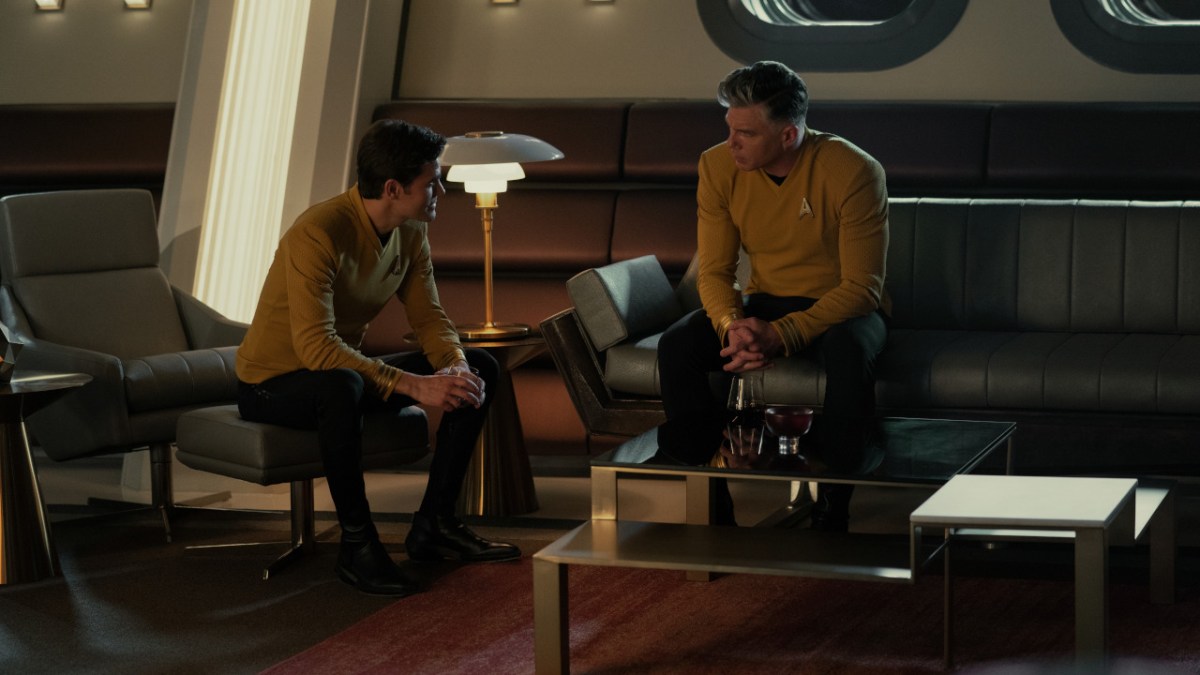
Every Shirt Color in Star Trek, Explained
Every shirt color in Star Trek has meaning and I’ll try my best to explain to Trekkies and non-Trekkies alike what that is. You know how some schools and most jobs require students and employees to wear uniforms? Well, Starfleet basically does the same with its officers. In The Original Series , Commanding officers wear gold, science officers wear blue, and engineering officers wear red. But what does that mean for all the different iterations of Star Trek ?
Commanding Officers of Star Trek
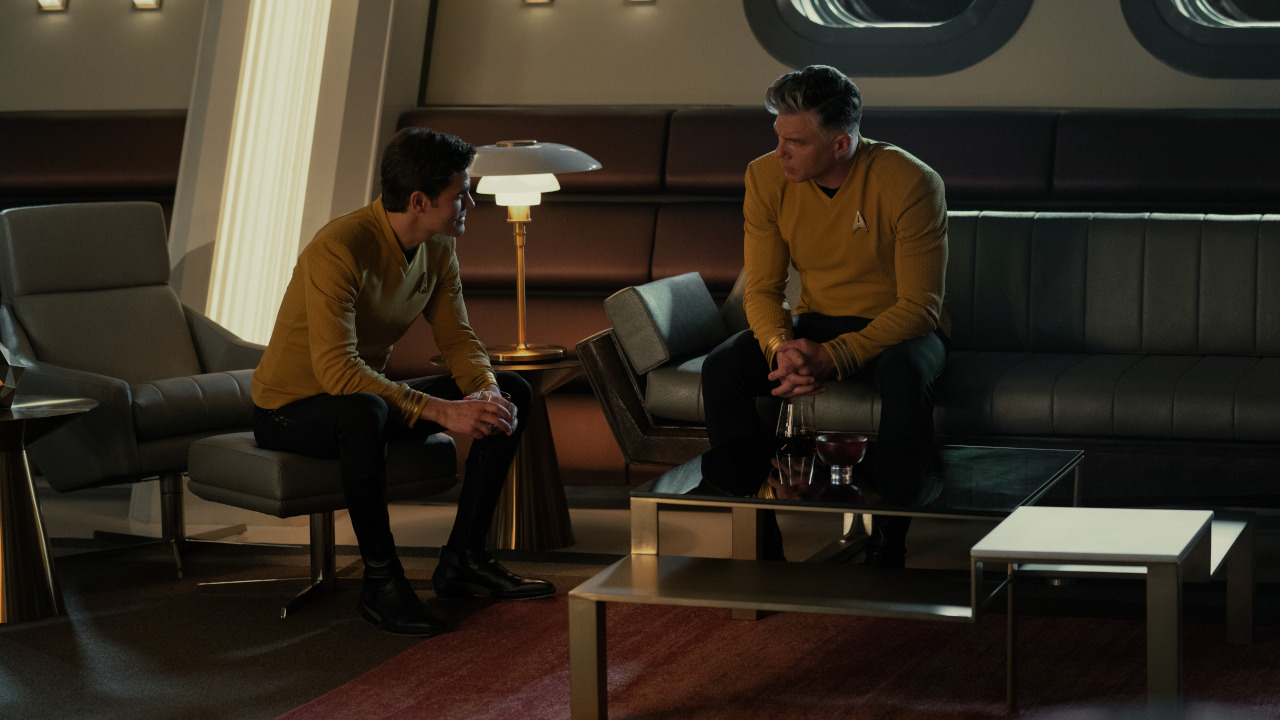
The classic shirt color of those in command positions is gold. Unless we’re talking about Captain Kirk’s green formal top in the “Journey to Babel” episode of The Original Series . (Captains Pike and Kirk revive these prime colors in Strange New Worlds .) Then Captain Picard came along in The Next Generation and the colors shifted to red and black.
Enterprise was later content to put Captain Archer in something that looked more appropriate for a car shop than an important space mission. But who are we to judge?
Discovery has since returned to red with gray sometimes peppered in for more official occasions. Luckily, however, it’s not the color of shirts that make the leader. It’s the person within them and how willing they are to make morally dubious decisions.
Related : 10 Best Star Trek Battles, Ranked According to IMDB
Science Officers of Star Trek
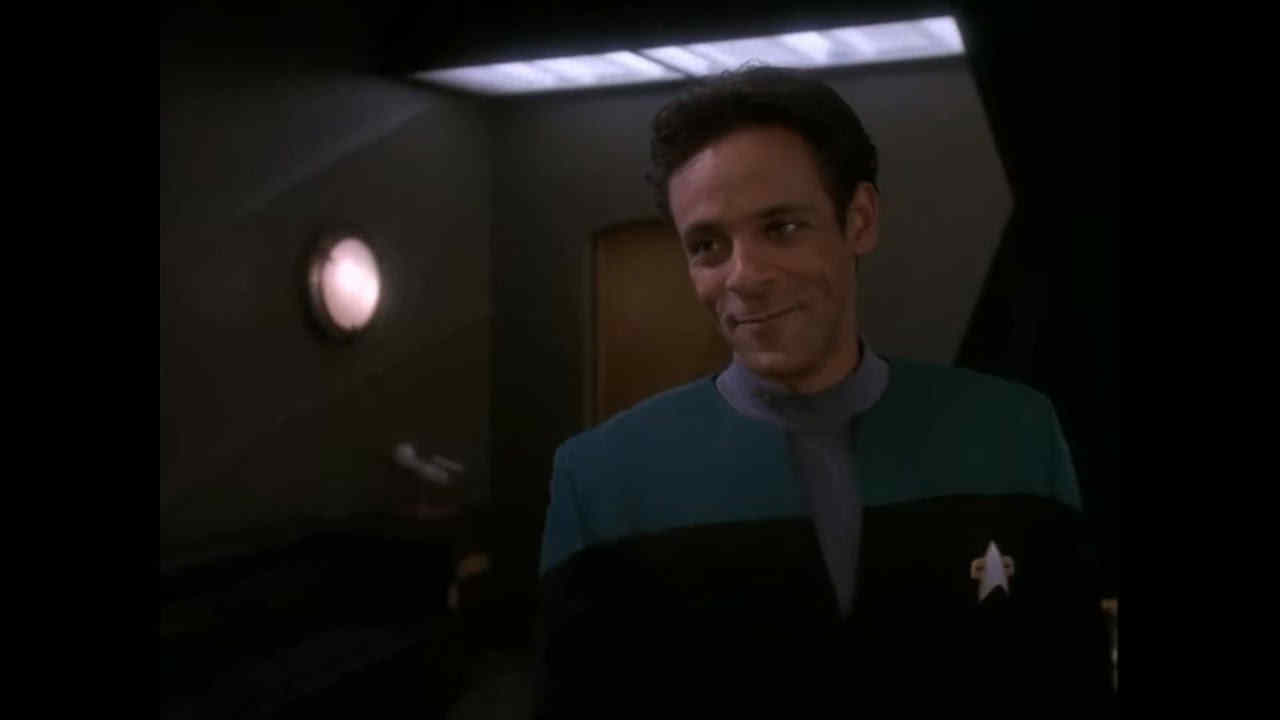
The shirt color of science officers has consistently been blue throughout Star Trek . The types of blue may change depending on what series you’re watching. Nevertheless, though, blue seems to be the staple of officers overwhelmed with trying to keep their officers alive from planet to planet.
Dr. Julian Bashir showed up in Deep Space Nine with a brash, overly confident can-do attitude. He was the first doctor in Star Trek to be yelled at rather than doing the yelling. He was also the first one to grow before our very eyes into a competent and dependable professional. But the blue in the collar of his shirt spoke to the tradition of those who came before him. For that, Dr. McCoy would be most proud.
Engineering Officers of Star Trek
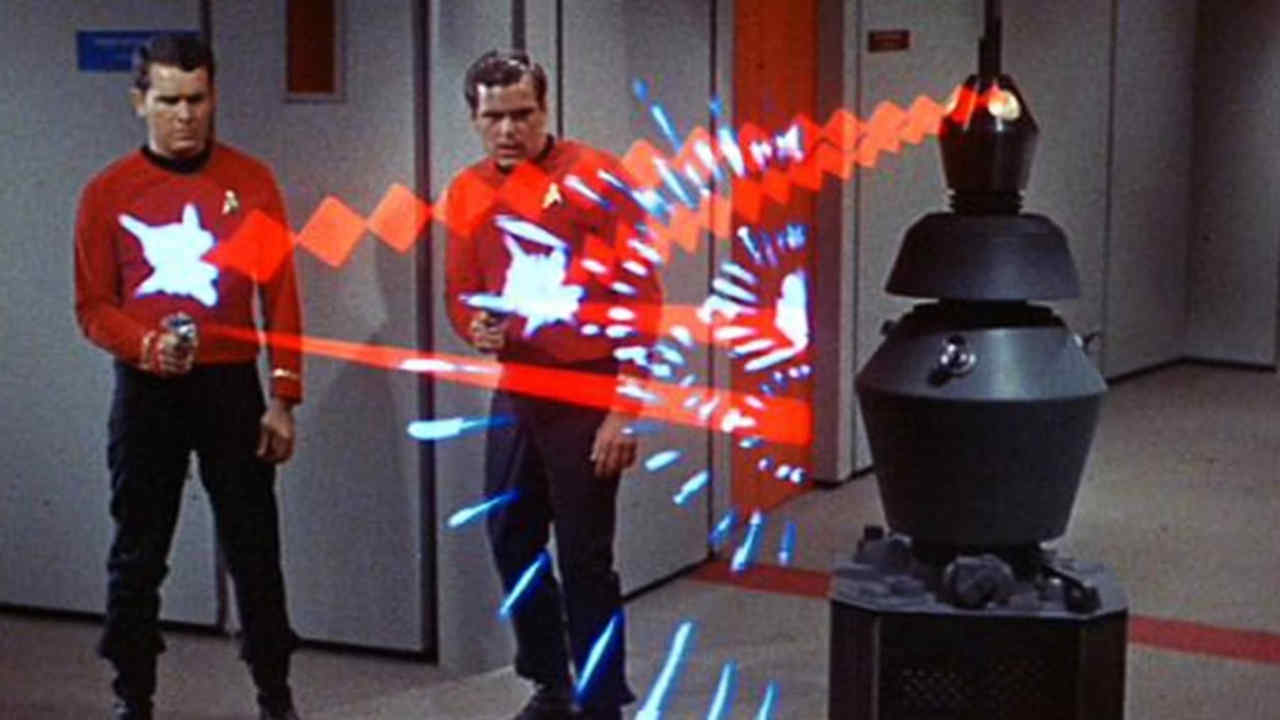
Speaking of tradition, the Red Shirts have continued to be synonymous with bad luck no matter what Star Trek TV series or movie they’re in. Everyone else is in a sci-fi story with hints of comedy and drama. Meanwhile, the Red Shirts are in a horror movie where they go off to investigate strange happenings and then just never come back.
Lt. Uhura is perhaps one of the only Red Shirts to make it out of a Star Trek series alive. Chief Engineers always do well because they’re part of the main cast and really likable (for the most part, at least). Taking Odo out of a Red Shirt probably saved his life. Then again, the chances of anything taking out Odo were slim anyway.
Hopefully, I’ve successfully explained the meaning of every shirt color in Star Trek . There are a lot of variations that have appeared through the years. All of the Enterprise crew, for example, just looked like mechanics. Even Discovery doesn’t have much variation in how the officers dress. Will that change with future Star Trek projects ? Only time – and Paramount Plus budget – will tell.

Star Trek Uniforms Fully Explained
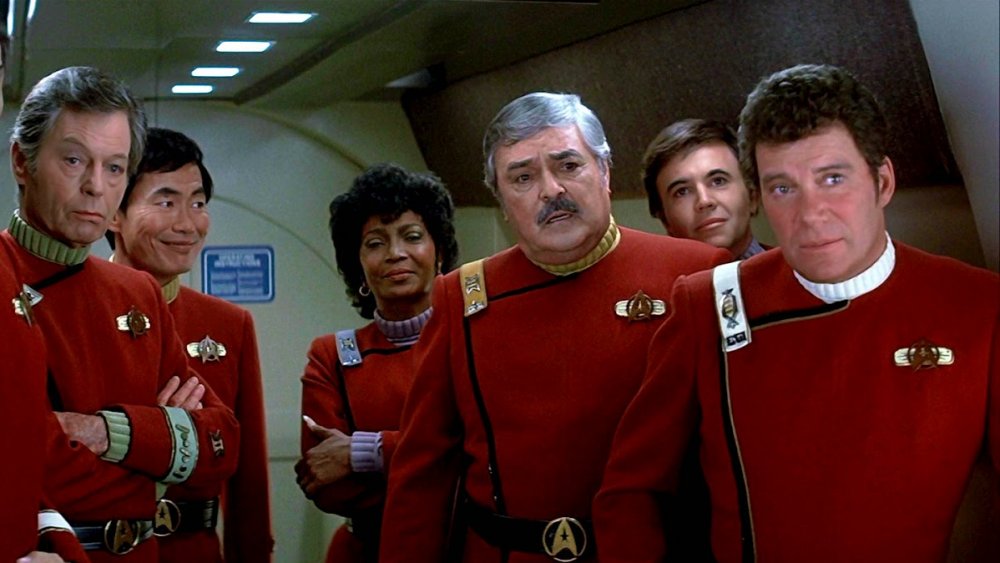
Since its premiere more than 50 years ago, Star Trek has been at the center of a growing web of culture, television, film, and fandom. With nine television series and 13 films, with undoubtedly more to come, there is a wealth of material to analyze and enjoy. Today, an enthusiastic fan can take just a single aspect of the Star Trek universe and dive into it for weeks.
Take uniforms. A seemingly simple concept, right? Star Trek generally focuses on the experiences of people serving in Starfleet, essentially a futuristic version of the Navy in space. So, Starfleet uniforms should be fairly consistent, even boring. Everyone's supposed to look like a cohesive group, so there should be little variation.
However, the uniforms of Star Trek are so varied and connected to the intricate fictional world of the franchise that it's pretty fascinating. Someone appearing on Star Trek: The Next Generation and then showing up again in a film like Star Trek: First Contact will probably have to fit themselves into two very distinct outfits. With more than five decades of stuff to go through, says CNET , there's a dizzying variety of looks for what's supposed to be a pretty staid quasi-military organization.
Practically everything about the history of Star Trek uniforms is linked to behind-the-scenes stories, real-world creativity, in-universe drama, and even a touch of fashion history here and there. From color, to cut, to material, there's a lot to learn.
Color is key to Star Trek uniforms
In Star Trek: The Original Series , which ran from 1966 to 1969, you can't miss the brightly hued uniform shirts sported by the crew of the starship Enterprise . Captain James T. Kirk and other members of the command staff sport golden yellow tops, says Mental Floss . Blue is reserved for the science department and medical personnel, so you'll see it on Mr. Spock, the second-in-command, and the ship's physician, Doctor McCoy.
And what of the folk in red uniforms? According to Star Trek lore, these poor "redshirts" are little more than cannon fodder, though, officially, red is for communications, admin, and security. If you're watching an episode where a random, red-clad crewmember is asked to beam down to the planet with the main cast, don't get too attached. They're probably going to get zapped, eaten, or otherwise annihilated to further the episode's plot.
Of course, there are some exceptions. Statistically speaking, says Nerdist , redshirts are not that bad off. Consider also that red shirts adorn major characters like Scotty, the ship's chief engineer, who made it through the entire series.
Now that you've got that settled, remember that it's only good for one series. In later Star Trek shows, red and gold switched places. Captains like The Next Generation 's Jean-Luc Picard wore a dark red, while his security chief, Worf, wore gold.
Starfleet rank is shown by pips and stripes
Like so many real-world military organizations, Starfleet hinges on rank. Crewmembers are expected to follow orders, but on starships that can carry thousands of people, who are they supposed to take seriously? That's where the rickrack comes in.
In Star Trek: The Original Series , rank was denoted by stripes of gold ribbon on someone's sleeves. The more stripes, the higher the rank. Generally speaking, says Atlas Obscura , two or three stripes means a captain. Commissioned officers are a safe bet for one stripe. Non-commissioned people get either a bit of braid or nothing at all. The stripes were brought back for the reboot films beginning in 2009.
The follow up series, Star Trek: The Next Generation went for something different during its 1987 – 1994 run. The colors became a more muted, and the old rank stripes, which, frankly, looked like something you might have picked up from your local craft store, were retired. In their place, officers wore "pips," subtle little pins, on their collars. The higher someone's rank, the more pips they sported.
Other films played around a bit with the rank symbols, like the different colors and badges shown in 1982's Star Trek II: The Wrath of Khan . Still, they weren't too off the original mark. Generally speaking, the more junk on someone's uniform, the more likely it is that you'll have to follow their orders.
The original series went for velour
Futurama 's Zapp Brannigan character, a send-up of Captain Kirk, is all about his velour uniform. The first Star Trek series really was into luxurious velour, too, but the fabric proved challenging to maintain. It's not as if the 1960s were known for comfortable natural materials, after all.
According to Esquire , the fabric initially used in Star Trek: The Original Series was a little flashy. Costume designers used a stretch cotton velour for the tops, with a black synthetic Dacron infused with sparkles for the pants. Both materials were meant to subtly glitter under studio lights, lending the uniforms a shimmery, 23rd-century, spacefaring feel.
Unfortunately, the velour was a flop. Many called it "that rotten velour," noting that the fabric tended to shrink in the wash and could tear easily. In the third and final season, designers substituted it for a double-knit nylon, says CNET , which proved to be a much hardier fabric, especially when it got thrown into the washing machine.
Captain Kirk's special green shirt was a little embarrassing
Originally, reports Atlas Obscura , the command staff of Star Trek: The Original Series was supposed to be sporting a muted green. Under the studio lights, though, the cameras read the green velour as a golden yellow. The production team simply went with it for the rest of the series.
Careful observers of the 1960s run will note that Captain Kirk is sometimes seen in a very green tunic-style shirt. According to an interview with series costume designer Bill Theiss , that's because it was made out of a different material. That particular shirt looked genuinely green. This is also why some of the colors in the original series seem to change, said Theiss. Even the miniature of the Enterprise could appear ever so slightly green under the right conditions.
William Shatner, the Canadian actor who played Kirk, wasn't necessarily fond of the tightly wrapped look, says Cinemablend . "It was a little embarrassing after lunch to have that tight green thing on you," he said.
Star Trek's women went from pants to miniskirts
The first pilot episode of Star Trek: The Original Series , " The Cage " is an odd duck. Though it was shot in 1964, it didn't make it to screens in its complete form until a Betamax release in 1989. Bits of the story were included in the season one two-parter "The Menagerie," but it contained only the briefest glimpses of what might have been.
These included things like a smiling Spock, different uniforms, and a woman in command wearing pants . Star Trek: The Original Series is notorious for its gendered uniforms. The men wore pants and long-sleeved shirts. Female crewmembers were confined to miniskirts so short that Lieutenant Uhura, the communications officer, always seemed on the verge of an embarrassing situation when she sat down.
That's partially why Number One, the second-in-command in "The Cage," stands out: She's wearing pants. Number One, played by Majel Barrett, is also a daring commander. But she wasn't considered right for the character. When Star Trek got its second pilot, none of the women were in command, and certainly none of them wore pants. Barrett returned, albeit as the emotional, mini-skirted Nurse Chapel.
Nichelle Nichols, who played Uhura, offers up a counterpoint. "I was wearing [miniskirts] on the street," she told the BBC . "What's wrong with wearing them on the air? [...] It was the era of the miniskirt. Everybody wore miniskirts."
The first Star Trek movie shook took uniforms in a weird direction
Star Trek: The Motion Picture looked like it was going to be a big deal. The 1979 film was the first time that fans would get to see their beloved crew on the big screen. Anticipation was high. Then, the movie debuted.
It landed with a dull thud. While die-hard fans still got enjoyment out of Star Trek 's film debut, most viewers couldn't get past the plodding story and dialogue-heavy scenes. It made just enough profit to justify a sequel, to be sure. SyFy contends that The Motion Picture did originate some interesting new trends for the franchise, like wearable communicators and redesigned Klingons . Still, few would point to this entry as their favorite Star Trek movie.
Some of the blame surely lies with the redesigned uniforms. Where The Original Series had colorful, if somewhat cartoonish togs for the crew, The Motion Picture made it look like everyone was going to the weirdest slumber party ever. According to Memory Alpha , the crew was now outfitted in two-piece tunics and one-piece jumpsuits in mind-numbing shades like pale blue and beige. At least the women on the crew were dressed in the same jumpsuits worn by the men. They might have looked oddly dull for space adventurers, but crewmembers like Lt. Uhura didn't look like they needed to worry about errant breezes. And, if nothing else, the space pajamas look pretty comfortable.
The Wrath of Khan redeemed Star Trek uniforms while cutting costs
Though Star Trek: The Motion Picture began the series tradition of changing Starfleet uniforms at every opportunity, rebooted uniforms didn't get very eye-catching until the second film. In Star Trek: The Wrath of Khan, both the plotting and the uniforms got a much-needed upgrade.
To be fair, the striking red jackets of The Wrath of Khan wouldn't have existed as we know them if it weren't for the beige jumpsuits of The Motion Picture . As revealed by Empire , costume designer Robert Fletcher, burned somewhat by his experiences on the first film, decided to stay on in an attempt to redeem his craft. Fletcher still had to work within budget, says Forgotten Trek . Indeed, the budget was smaller, since the studio had been spooked somewhat by the lackluster performance of the first motion picture. As a result, Fletcher rather cleverly utilized the old movie uniforms. His team dyed the tunics red because that was the shade that took best to the fabric.
Meanwhile, Fletcher added a few more militaristic details to the revamped uniforms, like boxy shoulders, stripes, and shiny rank insignia. Fletch referred to it as "Hornblower in outer space," referring to the popular Horatio Hornblower series, set in the era of the Napoleonic Wars. The maroon color proved so successful that it persisted far beyond the film and back onto television with the follow-up series, Star Trek: The Next Generation.
Star Trek: The Next Generation's uniform was all about spandex
While the uniforms debuted in Star Trek: The Wrath of Khan were structured, boxy outfits inspired by military getups, the theme wasn't going to last, for William Ware Theiss, who designed the costumes for Star Trek: The Original Series , was ready to completely revamp even his own designs. Theiss was called upon to design the costumes for the first year of Star Trek: The Next Generation , the follow-up series that premiered in 1987. According to Forgotten Trek , Theiss wanted to pull back from the structured look of Wrath of Khan and return to a softer appearance.
That meant spandex. Specifically, Theiss employed a heavyweight material, of the type often used for swimsuits. He also changed the color scheme, making red the color for command staff, while gold was switched to engineering and security. Blue remained the key shade for medical and science personnel.
While designers might have liked the spandex, it got poor reviews from the actors. The form-fitting material was unforgiving of a heavy lunch or brief dalliance with a slice of cake. Robert Blackman, who replaced Theiss in later seasons, came to the rescue with a different cut and wool fabric. Unfortunately, only the male actors got the best changes, like two-piece uniforms. Female actors like Marina Sirtis, who played Counselor Troi, were stuck in uncomfortable one-piece jumpsuits for a while longer.
Deanna Troi's exception confused Trek fans
In Star Trek: The Next Generation , ship's counselor Deanna Troi was actually a Starfleet officer, but you wouldn't know it from her clothes. While everyone else on staff was wearing the regulation Starfleet uniform, Troi was often stuck in revealing onesies that recalled the first film's unfortunate jumpsuits.
It may have something to do with Troi's gender. As quoted at Forgotten Trek , Marina Sirtis, who played Troi, took a dim view of how the show treated female characters. "The women on this show are very non-threatening," she said. "You don't see women in power positions." Troi was meant to be a soft, caring therapist. Perhaps her clothing was meant to reflect that gentleness, but with an admittedly sexist twist that lowered her necklines and kept Sirtis trapped in revealing spandex for much longer than her coworkers. Too often, her clothes reflected stories where Troi was made to be helpless or even outright dull for the sake of the plot.
Counselor Troi finally got to wear the real uniform in "Chain of Command, Part 1," a season six two-parter. In it, Captain Jellico, an uptight fill-in for Captain Picard, curtly tells Troi to just wear the uniform already. While the impetus for the wardrobe change might have been embarrassing for her character, Sirtis was delighted. As she told the BBC , "I was thrilled when I got my regulation Starfleet uniform [...] I got all my brains back."
The "skant" tried to reach gender equality but fell flat
We should give Gene Roddenberry some credit. While he was often of his time for things like scantily clad secondary characters on Star Trek: The Original Series , he genuinely tried to push back against cultural assumptions. Sometimes, it worked and became practically legendary, as when he helped to create a diverse bridge crew on the first television series. Other times, he pushed for costume parity that simply didn't land.
Roddenberry was involved with the production of Star Trek: The Next Generation from its 1987 premiere until shortly before his death in 1991. He was part of almost everything in the series, including the costume design. As reported by Star Trek.com , Roddenberry directed designer William Ware Theiss to design what became known as the "skant."
This take on the minidress was made out of the same spandex as the other uniforms. It was also meant to be unisex. Crewmembers of any gender would be able to wear the thigh-baring skant. Yet, it was a hard sell. The skant was ever-so-briefly seen on a male crewmember here and there in the first season, says SyFy, but never after that. Female crew like Counselor Troi wore it a bit longer, but actors and viewers alike thought it just made her look like a space cheerleader. Though you can understand what Roddenberry and company were going for, the skant just couldn't stay. It faded into fan lore and obscurity soon after the first season.
Star Trek: Deep Space Nine made the uniforms fit for actual work
Star Trek didn't stop with Star Trek: The Next Generation . The sequel series was followed up by a progression of films and further television series. These included Star Trek: Deep Space Nine , which premiered in 1993 and briefly ran concurrently with The Next Generation . Though both series are supposed to take place at roughly the same time, the uniforms seen on Deep Space Nine were a serious departure.
Costume designer Robert Blackman returned to the jumpsuit design but mercifully stayed clear of figure-hugging, back-breaking spandex, says Forgotten Trek . Instead, the looser jumpsuits were made out of wool. Blackman had, like earlier designers, discovered that wool took dye better than other fabrics and held up to repeated washings.
The softer uniforms looked like they could exist in a real, workaday reality. Characters like Chief O'Brien can be seen in the bowels of Deep Space Nine, a scrappy space station inherited from its previous Cardassian occupants. His jumpsuit, based in part on a mechanic's outfit and NASA workaday gear, looks right at place in the more gritty, realistic world of Deep Space Nine .
Star Trek: Lower Decks brings back color and might explain a big mystery
Star Trek: Lower Decks is an animated comedy series, the first ever to take a look at the ridiculous side of Star Trek . While it's very definitely a silly take on the franchise, the Lower Decks series actually holds a clue to the ever-changing and seemingly inconsistent uniforms across the series.
In part, the uniforms of Lower Decks are an homage to a never-used 1994 redesign. According to Trek Movie , creator Mike McMahan realized the discarded uniform design for the Star Trek: Generations movie was just right for his series. It calls back to The Next Generation just enough to make connections but remains distinct and colorful in its new two-dimensional context.
This latest series might also help explain the constantly shifting Starfleet uniforms. Careful viewers may have already noticed that different ship and station crews sport wildly different looks, even when they're supposed to be taking place at the same time.
Inverse points out the apparent fact that Starfleet uniforms seem to correspond to very specific ships and jobs. Someone sent to a space station like Deep Space Nine would wear one uniform, while another crewmember on Picard's Enterprise would sport something noticeably different. An outside viewer could still see they were Starfleet personnel but might correctly guess they were stationed in different places. The looks on Lower Decks , which are their own unique creations, add more evidence to support this theory.

Star Trek Uniform Color Meanings
What is the meaning of the uniform colors in Star Trek? This post will cover the original crew, the next generation (TNG), and beyond, including deep space 9 (DS9), and Voyager.

Generally, the different uniform colors helped to differentiate between the different duty positions, levels of authority, and generally the command structure of the federation, and the crew on the starships.
In the Star Trek universe, the colors of the uniforms worn by crew members hold specific meanings. Let’s break it down:
Original Series
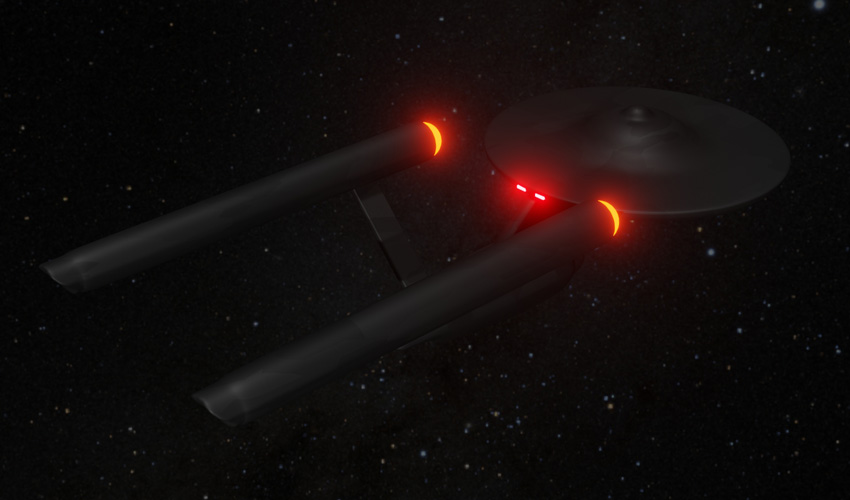
Red Uniforms: These are typically worn by crew members in engineering, security, and communications roles. Notably, Lt. Nyota Uhura and Montgomery (Scotty) Scott wore red uniforms. Wearing red on the bridge is considered a high honor. However, there’s a running joke about crew members in red shirts often meeting unfortunate fates during away missions. So, if you’re on the Starship Enterprise and want to survive, don’t wear red!
Blue Uniforms: These represent medical and science divisions. They’ve remained consistent across various “Star Trek” series. Blue shades indicate ship medics and scientific personnel.
Gold Uniforms: Worn by command officers, gold symbolizes the importance of strategic decisions. Command staff, including Captain Kirk, would wear these iconic golden shirts.
TNG, DS9 & Voyager
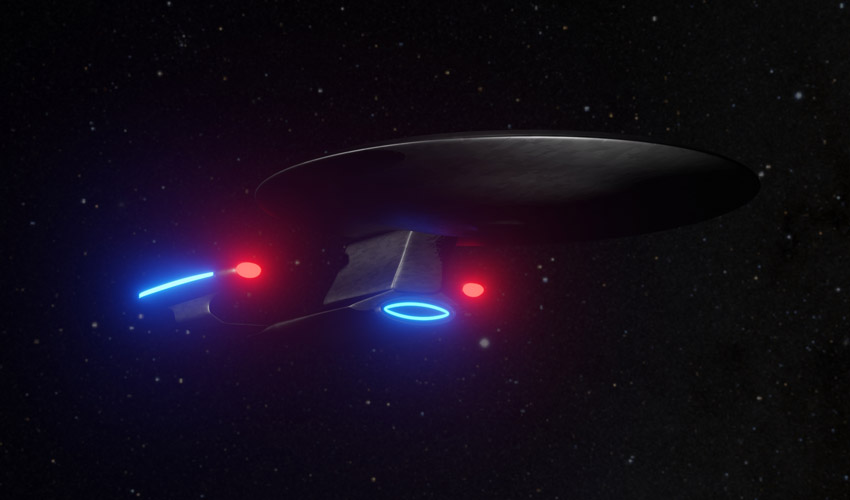
In Star Trek: The Next Generation (TNG), and beyond, not only did the uniforms modernize, the color meanings changed. Let’s delve into the significance of each uniform color:
Red Uniforms: These are worn by command staff. Captain Jean-Luc Picard and his senior officers sport these crimson hues. Red signifies leadership, decision-making, and strategic roles. If you’re in red, you’re at the helm of the starship, making critical choices for the crew and the mission.
Blue Uniforms: Medical staff wear blue. Dr. Beverly Crusher and other medical officers would have a blue uniform. This remains the same as in the original series.
Gold Uniforms: Operations and security staff wear gold. Lt. Commander Geordi La Forge, Lt. Worf, Lt. Tasha Yar, and Chief O’Brien fall into this group. Gold symbolizes efficiency, engineering, and tactical prowess. These officers keep the ship running smoothly, maintain systems, and ensure security.
In summary, the colors of Starfleet uniforms reflect the crew members’ roles and responsibilities as they explore the final frontier!
Why The Uniform Colors Change?
The switch in uniform color in the 24th century likely aimed to move away from the negative connotation associated with “redshirt” deaths, those unfortunate crew members who often met their demise during away missions.
The evolution of Starfleet’s uniform colors reflects different visions of the franchise’s costume designers over the past 50 plus years. Each new designer brings their own perspective, adapting the color meanings while honoring the legacy of this beloved sci-fi saga.
Related Colors & Posts

Similar Posts
Use of different colors in retro games.
How were colors used when it came to old retro games, why different characters had different colors? As a child I loved video games. The arcades were heaven for me as a child. I particularly found the usage of different colors fascinating in certain video games. The different colors signify different things with different meanings….
Lightsaber Color Meanings
In the world of Star Wars, the lightsaber is one of the most memorable and iconic objects within that universe. So what are the lightsaber color meanings for red, green, blue, purple and others, the weapons of the Jedi and Sith mean? Lightsabers actually get their color from what are known as kyber crystals. However,…
Star Trek: What Ranks Do Each Color Shirt Represent?
It's time to take a deeper dive into the importance of Starfleet fashion, and how it has changed over the years.
Over the many years of thriving Star Trek TV shows and movies, there has always been special attention shown towards the overall design of the science fiction genre defining franchise. Gene Roddenberry, the show's creator, even had a specific set of design rules for what the Federation ships were supposed to look like , ensuring that they would be instantly recognizable as Federation just from a quick glance. The importance of recognizable themes stayed strong, from the fairly logical design of the warp and transporter technology , all the way to what is potentially the most important visual aspect of the show: the costumes.
While there have been various changes made over the years (although, not as drastic a change as that of Klingon appearances ), the Starfleet uniforms stay fairly similar. With the expedition of The Original Series, the colors used by the officers have stayed fairly consistent, each representing a different job aboard the ship. So what exactly do these colors mean?
REALTED: Star Trek: Who Was Captain Picard’s Greatest Nemesis?
One of the most recognizable to anyone who is away from the age-old Star Trek joke about the poor officers who are donned in red. However, the idea that wearing a red shirt in the franchise is a death sentence is not only a myth , but is something that changed drastically after the official color changes occurred at the start of The Next Generation. In The Original Series, the red uniform was the most used aboard the ship, and was worn by those in engineering, security, and communications. The most notable of red wearing characters was chief engineer Scotty, and the groundbreaking Uhura (played by the late Nichelle Nichols ).
After the uniform change made in TNG, the red shifted meaning. It was now reserved for the command staff, including Captains such as Picard, Janeway, and the morally questionable Sisko , as well as high ranking officers such as commander Riker, who was second in command during the TNG days. This change was present until the Kelvin timeline films and the more recent Strange New Worlds series, which both reverted to The Original Series color designations due to their timelines coinciding.
The blue uniform color was the one designation not to change after the great uniform change of 1987 (when the pilot episode of TNG came out). The blue uniform was for the science and medical staff. It was worn by officers such as the incredibly iconic lieutenant Spock from The Original Series , the ships' science officer, as well as the early Dr Julian Bashir on board the space station in Deep Space 9 , although this was later changed to green.
Gold, or yellow depending on the desired grandness, was the color of command officers during The Original Series as well as Strange New Worlds, and the Kelvin timeline films . Kirk was most notable for wearing this, a bright yellow uniform which was actually, due to the late 60s limitations for color film, slightly green in real life. This was because the yellow didn't record well, so the yellow-green had to be made and worn to make it look golden yellow on screen. Gold was also reserved for just the captain on board the ship, rather than those in command positions. This explains why Kirk wore gold, and Spock, his second in command, did not.
Yellow/gold then shifted in during TNG onwards to represent the operations and security staff, as well as engendering. The disability-positive representing Geordi LaForge is most notable for wearing this color for this time, being chief start of engineering.
The uniforms that were actually supposed to be green, rather than the greenish yellow, were rarely seen during The Original Series and were the formal attire for command staff. Kirk is seen wearing the color on multiple occasions. During TNG, the green was replaced by the longer dress robe-like red uniforms often donned by Picard. Green also replaced some medical officers during the Voyager and DS9 series, which characters such as the Holographic doctor donning the jungle green uniform. This change, despite being fairly obvious to some, often goes unnoticed with casual fans, as it is much less dramatic than the red and gold color switch.
There are plenty of other variations on the classic Starfleet uniform, which has gone through multiple iterations over the years. They range from the brightly colored uniforms found within The Original Series and the early days of TNG to the more dulled down, subtly dark variations of the TNG movies and the much grittier DS9. However, they have always kept a small pop of color in there to help audiences instantly know what this character's role aboard the ship was. Even Enterprise , which was set before the foundation of the Federation, used color as a visual indicator of role, following very subtly the Original Series color coding, with the small shoulder rectangles of color on their otherwise fairly plain and similar uniforms.
MORE: Star Trek: The Strange Rules Of Transporter Immortality
- Sep 7, 2023
Star Trek Uniforms: The Meaning Behind The Colors
When the original Star Trek series premiered in 1966, it wasn't just the groundbreaking storytelling that caught the audience’s attention; it was also the iconic uniforms worn by the crew. The most striking feature is the bright color scheme. The uniform colors were used to help viewers instantly recognize the roles of the crew. Command officers like Captain Kirk wear gold; science and medical officers like Spock and McCoy wear blue; engineering personnel like Scotty and security officers wear red. These colors were specifically chosen to be visually striking on the color TVs that first became widely available in the 1960s when the show first aired.
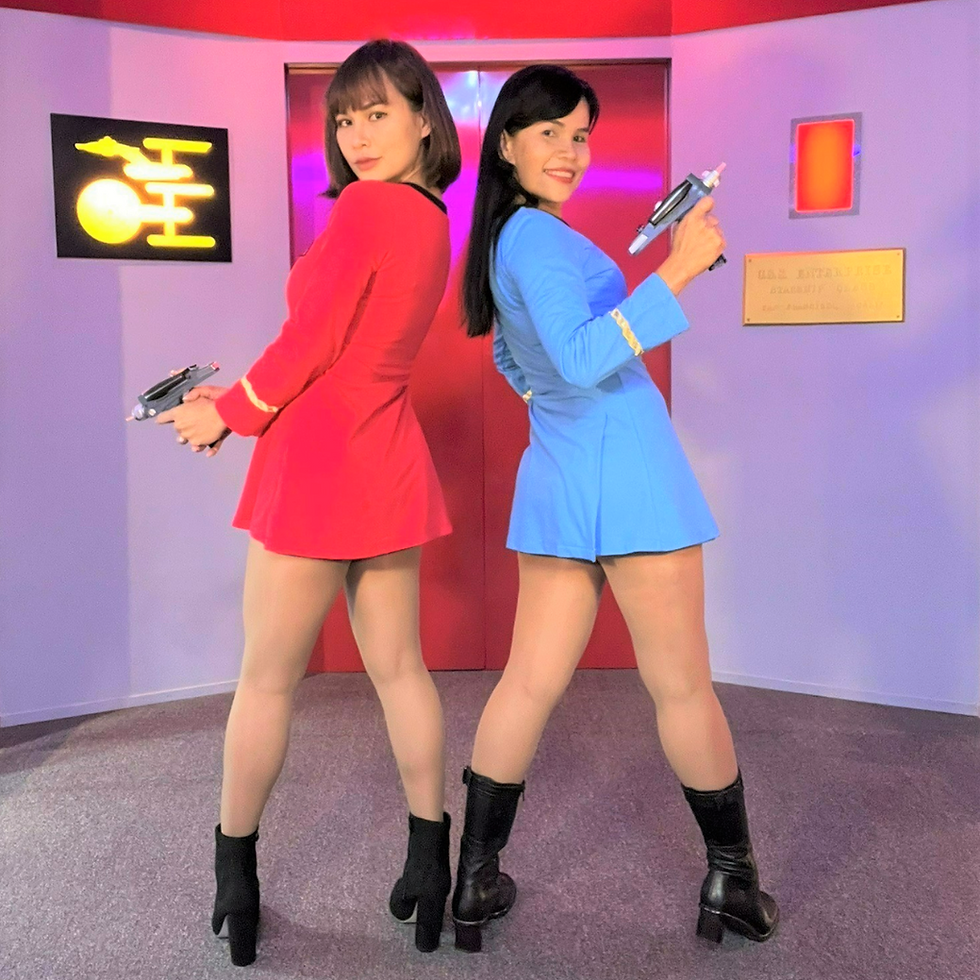
So, what was the actual meaning behind the selection of uniform colors?
Gold, worn by command officers, was chosen to symbolize the importance of strategic decisions.
Blue, worn by science and medical personnel, represents those engaged in the exploration of both outer and inner frontiers: the universe and the human body.
Red, worn by engineering crew members and security staff, stands for the heart of the ship: the people who keep it running.
With regard to the women’s short uniform dresses, these were tastefully designed, and there was an emphasis on the characters' confidence, competence, and individuality.
At that time, this marked a significant departure from the stereotypical portrayal of women in science fiction as mere eye-candy or damsels in distress. Women were portrayed as capable professionals in functional and stylish attire.
And so the choice to use different colors for the uniforms was an intentional decision to visually represent the different crew member’s functions within a team. It symbolized the show's underlying belief in a future where the clear diversity of roles and responsibilities are essential in contributing to the unified mission of successfully exploring the galaxy.
Subscribe for photos and articles
🖖😍 Star Trek Gigi
Recent Posts
The Sexy Influence of Star Trek Short Dresses
I wonder why they changed the colors in the TNG era. Maybe Red just felt like a Command color...
This was an amazing read and I now know the reasons for the colours. I love the TOS uniforms. They are my absolute favourites. If only we saw a man wearing those miniskirt uniforms to show even more diversity. That would have been awesome. Either way, the TOS uniforms looks good and served a purpose whilst not seemingly being militarised. A beautiful blog. 😊🙏🖖❤
You are very welcome, Gigi. 😍❤🖖

- [ April 25, 2024 ] 18 Ron Swanson Quotes that Know What They’re About Articles
- [ April 24, 2024 ] The Detroit Youth Choir is Coming to SporcleCon! Articles
- [ April 23, 2024 ] Partner Spotlight: TD’s Tailgate in North Canton, OH Sporcle Events
- [ April 23, 2024 ] Partner Spotlight: Barkyard n’ Brews in Fort Lauderdale, FL Sporcle Events
- [ April 23, 2024 ] Partner Spotlight: Union Rec in Ann Arbor, MI Sporcle Events
Star Trek Uniform Colors – What Do They Mean?
Space…the final frontier.
In 1964, Gene Roddenberry pitched his idea for a space-age Western to NBC. His hope was to create a science fiction series that was like “Wagon Train to the stars,” but he also wanted the show’s content to reflect some of the very real problems that were plaguing Earth at the time. He felt the show had the potential to provide viewers with a realistic glimpse into a more utopian society, one which he thought was possible for humanity if they could learn some lessons from the past.
In 1966, his vision came to fruition when Star Trek first hit the airwaves. Over time, the show would go on to earn high praise for its cultural influence. The Original Series featured one of TVs first multiracial casts, one that also portrayed women in working roles, and many have cited Star Trek as being the inspiration, at least in part, to some of the technologies we have today, like cell phones and computer tablets. We even have a new way of speaking to each other thanks to Star Trek with the creation of Klingon , the world’s most popular fictional language.
The attention to detail Roddenberry brought to creating his fictional universe was immense, and while he may have helped inspire the iPad, not everything from Star Trek has caught on just yet. Apparently, his vision of a more utopian future also included velour tops, spandex jumpsuits and plastic. Something tells us we still have a ways to go before we start seeing fashion models walking down the catwalk dressed like Worf.
While the Star Trek uniform colors might seem highly illogical , that doesn’t mean they actually lacked that same awareness Roddenberry used elsewhere in the series. In fact, a lot of thought went into the costume design. The colors and insignia on each uniform can actually be quite telling.
It turns out there is a reason you should avoid wearing a red shirt during exploration missions.
To Boldly Go Where No Costume Designer Has Gone Before
To stay in line with his vision of a realistic future, Roddenberry wanted crew members of the Enterprise, the fictional star-ship of the series, to have realistic jobs and job titles. They used the US Navy as a guide, creating comparable ranks and job structures. There was a commander, a handful of lieutenant commanders, lieutenants, and numerous other roles. The various positions were eventually learned by viewers throughout the course of the show, but it was the uniform colors that gave the real hints as to who does what on Enterprise.
The Starfleet did not have randomly assigned uniform colors. Each color actually represented one of the ship’s various jobs and service roles. Here’s a quick breakdown on the Star Trek uniform colors from the Original Series:
- The command division wore gold shirts. This includes Captain Kirk, Lieutenant Sulu, and Pavel Chekov.
- The science and medical staff wore blue shirts. This includes Lieutenant Commander McCoy and Commander Spock.
- The engineering and communications division wore red shirts. This included Chief Engineer Scotty and Communications Officer Uhura.
- The security division also wore red shirts. You might know these people as the careless supporting characters that are immediately killed whenever the crew is confronted by a new enemy. We told you to avoid them.
This all gets a little messy in later Star Trek series. In The Next Generation, for example, command staff wore red and it was the engineering and security staff that wore yellow. Each new Star Trek movie that comes out further complicates things. Costume colors switch in almost every new adaptation.
Sleeve stripes highlighted the rank of crew members. The meaning of these has also changed throughout the course of the franchise. Generally speaking, the more stripes one had on their sleeve, the higher ranking they were. So captains often wore two or three stripes, while other enlisted officers might only have a single stripe.
Gold Is The New Green
Now for the really confusing part. Remember how Captain Kirk and crew wore those gold command shirts?
The Star Trek uniform colors were originally supposed to be red, blue and green. If you pay close attention, you’ll see this was the case. Captain Kirk’s outfit was actually more of a lime green when he was on set, but under bright studio lights, it appeared gold on film. As Star Trek costume designer William Theiss describes , “It was one of those film stock things. It photographed one way – burnt orange or a gold. But in reality was another; the command shirts were definitely green.”
Despite gold being canonized in later show dialog, when the lights are off, Kirk definitely shows his true colors.
Regardless of what color they were, one has to respect the vision and contributions that Star Trek has brought to the science fiction genre. Gene Roddenberry wanted everything in his fictional universe to have a specific purpose. While the series has had it’s share of highs and lows, one has to respect the attention to detail given. Just hope you never find yourself stuck wearing one of those red shirts.
About the Author:

Mark Heald is the Managing Editor of Sporcle.com. He enjoys spending time with his family, traveling, and bemoaning the fact the Sonics left Seattle.
- Mark Heald https://www.sporcle.com/blog/author/markh/ Why Do April Showers Bring May Flowers?
- Mark Heald https://www.sporcle.com/blog/author/markh/ Sporcle 2023 Year in Review
- Mark Heald https://www.sporcle.com/blog/author/markh/ Countdown to Five Billion: Wrap-Up
- Mark Heald https://www.sporcle.com/blog/author/markh/ Where Do Sporcle Events Questions Come From?
Related Articles

Why Do We Have Red States and Blue States?
(Last Updated On: September 10, 2018) During every election cycle, we hear the terms “red state” and “blue state” over and over again. Why do we have red states and blue states in the first […]

19 Stanley Hudson Quotes for Professional Idiots
(Last Updated On: October 6, 2020) 19 Stanley Hudson Quotes for Professional Idiots There are quite a few fans of The Office who probably identify with Jim. Makes sense, he is the self-insert character after […]


Why Do Men’s and Women’s Clothes Have Buttons On Opposite Sides?
(Last Updated On: April 14, 2024) You might never have noticed or thought about this until someone else brought it up, but yes, women’s clothes have buttons on the left side and men’s clothes have […]
Copyright © 2007-2024 Sporcle, Inc.
- Celebrities
- Secret Invasion
- The Marvels
- Disney Plus
- Apple TV Plus
- Dwayne Johnson
- Brie Larson
- Ryan Reynolds
- The Witcher
- About & Advertising
- Privacy Policy
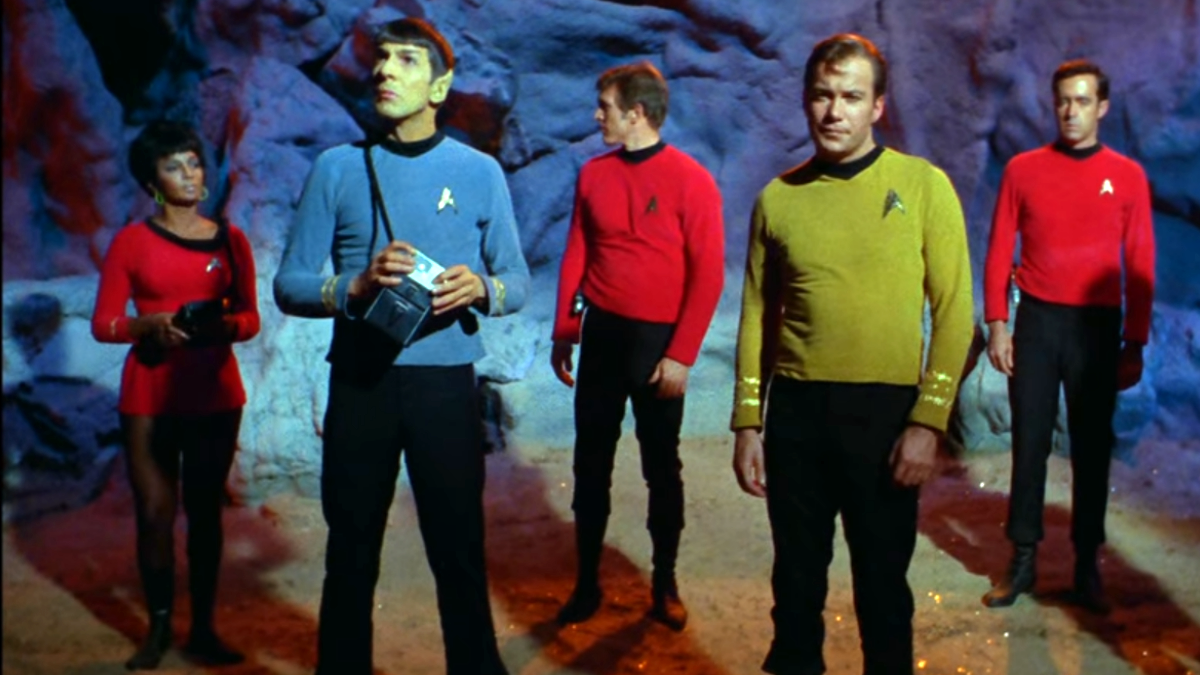
‘Star Trek’ uniform colors, explained
Everyone knows the iconic Star Trek uniforms. The brightly-colored outfits amazed viewers seeing color TV for the first time in the 1960s and helped to define the unique aesthetic style of the Star Trek universe, becoming an instantly recognizable feature of the shows.
The 23rd Century
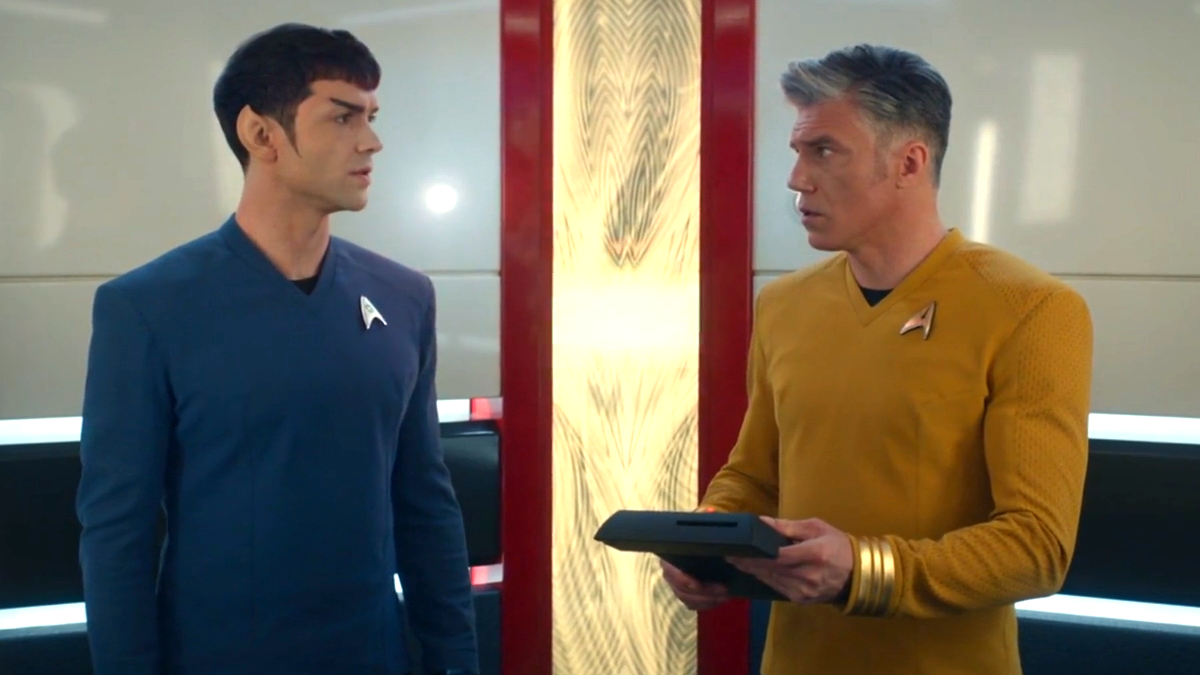
In The Original Series , there were three uniform colors . Each color represented a certain duty division aboard a starship or station. Gold, as worn by Kirk and Sulu, denoted the command division of Starfleet, which included most ranking officers and administrative personnel. Blue, as worn by Spock and McCoy, denoted the sciences division. This included researchers and medical staff. Red, as worn by Uhura and Scotty, denoted the operations division which covered a wide range of specializations such as engineering and security. Each color choice was bold and striking, meaning viewers could immediately tell what position any new character had in Starfleet.
The Original Series gave rise to the infamous phenomenon of “redshirts.” Security officers wore red shirts and would regularly put themselves in harm’s way. Enterprise crew clad in red were massively more likely to be killed than their counterparts in the other divisions. A redshirt’s life could be painful and short — they would be blown up by alien weaponry, plunge head-first into bottomless chasms, or even have all their red blood cells surgically removed by malevolent cloud creatures. Around 26 officers in red uniforms died during the course of the series’ three-year run. In the season two episode “ The Apple ,” four unfortunate redshirts are killed navigating a jungle deathtrap, being struck by lightning, shot by plants, and falling onto landmines. Even by the cruel standards of the show, this ranks as a bloodbath.
Strange New Worlds — set very shortly before The Original Series — keeps the same uniform colors, but adds a new one. A white uniform denotes someone working as a member of medical staff, but these were seemingly phased out in favor of standard blue uniforms by the time of The Original Series .
Star Trek: Discovery , a prequel series set a little further prior to The Original Series , introduced a new color-coding system. All uniforms were made of dark blue fabric, with division denoted by metallic stripes on the shoulders. These stripes were gold (command), silver (sciences), and copper (operations). These clothes were super-sleek but looked too much like Navy uniforms, and it could be hard to tell at a glance who was part of what division.
The 24th Century
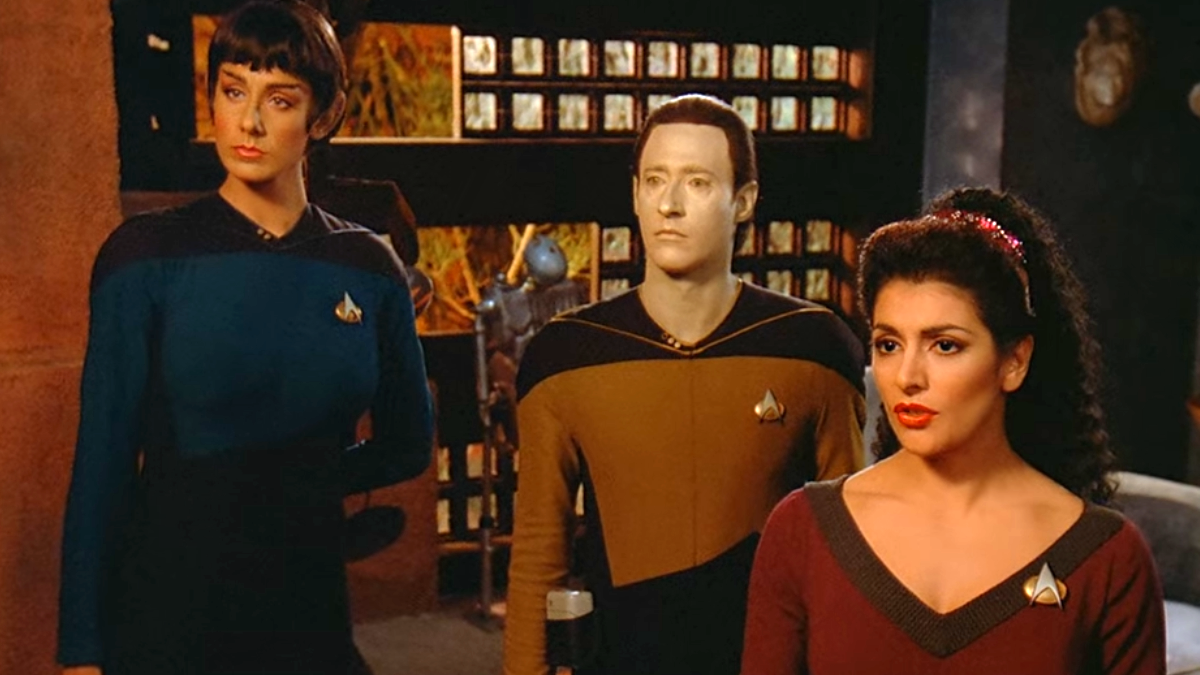
By The Next Generation , the uniform colors had changed . While blue still denoted science and medical, the meanings of red and gold were inverted. No reason was ever given in-universe for this, but the real-world explanation is that Next Generation actors looked better in certain colors — Brent Spiner as Data, for example, was deemed to look far better in gold than in red or blue. The change also came partly as a result of the Star Trek movies of the 1980s, where all Starfleet personnel were shown to wear red uniforms (the fabric for the costumes took better to red dye). Kirk had been seen wearing red for the movies, so it was felt that audiences would come to associate red with command.
Whatever the century, series, or ship, Star Trek just wouldn’t be the same without everyone clad in brightly colored pajamas. Too many modern science fiction shows have their actors wear drab, dark, soulless uniforms. Strange New World s is proudly carrying on the multi-colored tradition set way back in 1966.
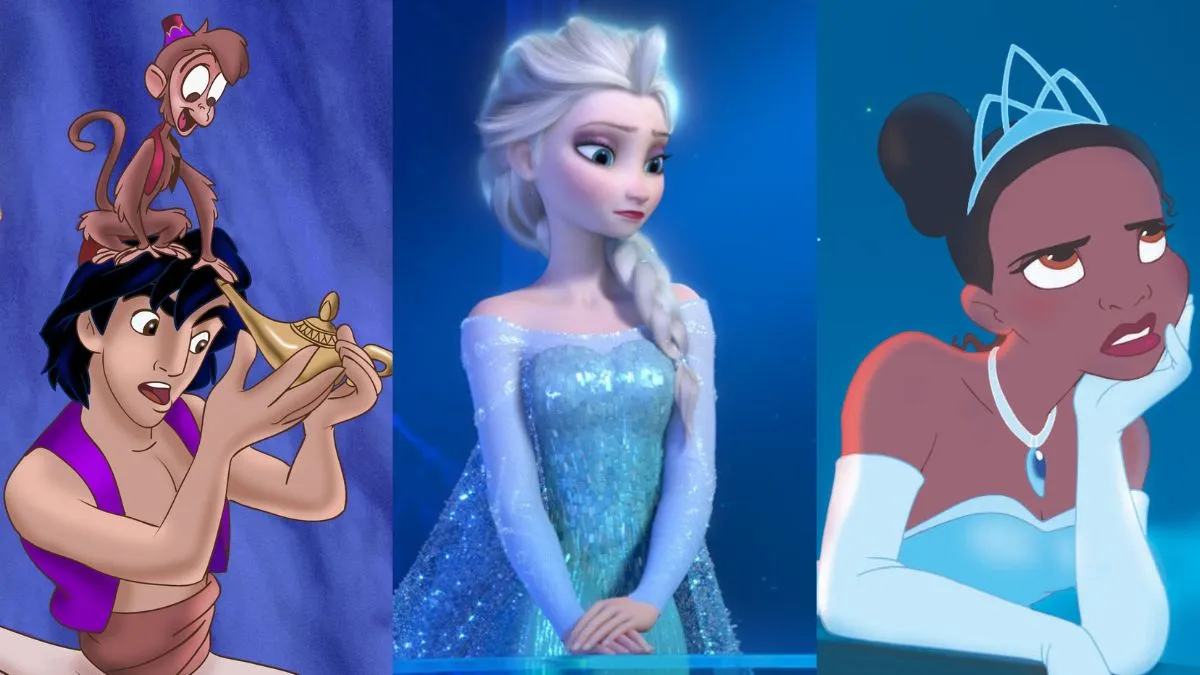

Starfleet uniform
- View history

Starfleet uniforms in 2371, showing two separate styles in use at once
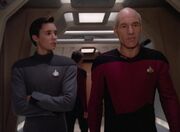
A provisional officer's uniform alongside a standard duty uniform
Starfleet uniforms were uniforms worn by individuals serving in the Federation Starfleet , originally a United Earth organization. These uniforms facilitated the wearers' needs as both scientists and researchers , as well as Starfleet's military role. The uniform and combadge used by Starfleet personnel may vary by the ship or facility they were assigned to, or the officer's rank or department. These were often retained even when visiting other Federation locations. ( TNG : " The Child "; DS9 : " Homefront ", " Tears of the Prophets "; LD : " We'll Always Have Tom Paris ", " Kayshon, His Eyes Open "; DIS : " Saints of Imperfection ")
Casual duty attire also allowed for considerable variation of uniform aboard a Starfleet vessel, though it was ultimately up to the captain's discretion. Wearers were expected to abide by the Starfleet dress code , though special exceptions were sometimes made for certain aspects of an individual's cultural heritage, such as Worf 's Klingon baldric , Nog 's Ferengi headdress , and the earrings of Ro Laren , Kira Nerys , and Shaxs . ( VOY : " Learning Curve ", et al.) According to Elim Garak , " I think Starfleet should allow their officers more latitude in accessorizing their uniforms. You'd be surprised what a nice scarf can do. " ( DS9 : " Broken Link ")
On two occasions, the term " Federation uniform " was used to describe Starfleet uniforms.
In 2369 , the Bajoran civilian Mullibok , who was being evicted from his home , asked Commander Benjamin Sisko how many Federation uniforms he planned on sending down to have him removed. ( DS9 : " Progress ")
In 2372 , Chakotay referred to his as a Federation uniform as he explained to Kar how it was like the Jal name that the Kazon earned. Chakotay told him that his uniform was earned through " years of study ", and " learning about science and ships and navigation , " adding too, that he was further taught to be "[..] prepared us to defend ourselves in battle. They prepared us very well. And we had to pass many difficult tests before we were given the right to wear the uniform. " ( VOY : " Initiations ")
- 1.1 Command
- 1.2 Operations
- 1.3 Sciences
- 2.1.1 Type #1
- 2.1.2 Type #2
- 2.1.3 Type #3
- 2.1.4 Type #4
- 3 Uniform variations
- 4 Dress uniforms
- 5.1.1 Design
- 5.2 Ambiguous uniform
- 5.3 External links
Divisions [ ]
Starfleet uniforms were classified by color among the command, sciences, and operations divisions. Occasionally, the uniforms were also broken down by department, while displaying rank insignia conspicuously. The color scheme had varied over time throughout Starfleet history, but the uniforms were designed for comfort even in the most extreme environments. ( DS9 : " Trials and Tribble-ations ", " Let He Who Is Without Sin... ")
Command [ ]
The command division was the head of Starfleet, with most of the ranking officers in Starfleet Command wearing these colors. Generally, this division was responsible for the administration of starships , starbases , and space stations .
Operations [ ]
The operations division was the backbone of Starfleet, encompassing the engineering , security , and support departments. This division was responsible for technological innovation and for maintaining and defending the Federation.
Sciences [ ]
The sciences division was the heart of Starfleet, composed of the exploratory , medical , and mental health departments.
Uniform styles [ ]
Unknown eras [ ].
These Starfleet uniforms were introduced between the 24th and 31st centuries .
Type #1 [ ]

A female officer in an unknown uniform
This uniform was worn by an operations division officer , as seen in a photo within the Transporter Facility maintained by Chief Petty Officer Carlton Dennis . ( LD : " Grounded ")
Type #2 [ ]
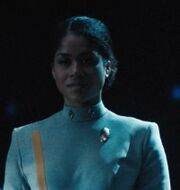
A female junior officer in a uniform from an unknown era
This uniform was worn by one of Tal 's hosts . ( DIS : " Forget Me Not ")
Type #3 [ ]
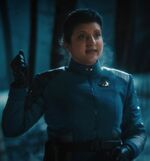
A holographic representation of a female lieutenant
This uniform was worn by officers in an unknown era. ( DIS : " Su'Kal ")
Type #4 [ ]
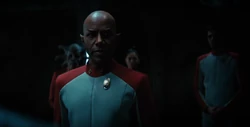
Holographic representations of officers in uniforms from an unknown era
This uniform was worn by the delegation welcoming the Kelpien and Ba'ul Alliance into the Federation. ( DIS : " Su'Kal ")
In the 23rd century , similar uniforms had been in use as cadet outfits. ( DIS : " Through the Valley of Shadows ")
Uniform variations [ ]
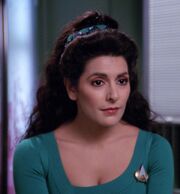
Troi in her casual attire
Some officers wore alternate uniforms. Deanna Troi often wore casual clothing while on duty, and T'Pol retained her original Vulcan uniform with a few concessions to her Starfleet rank and ship assignment. Other officers, such as Worf, Montgomery Scott , and Ro Laren, were allowed to wear accessories relating to their culture with their uniforms, but this was at the discretion of the captain. Uniforms were also altered to accommodate non-humanoid officers, such as the three-armed, three-legged uniform of the Edosian Arex , and the uniforms for beluga whales Kimolu and Matt . ( ENT : " Borderland "; Star Trek II: The Wrath of Khan ; TNG : " Ensign Ro "; TAS : " Mudd's Passion "; LD : " First First Contact ")
Uniforms were also adapted to environmental or atmospheric conditions. When exploring the planet Tyree , Benjamin Sisko and colleagues wore long, flowing gown uniforms to deal with the sand . They featured a colored stripe to represent departments. ( DS9 : " Shadows and Symbols ")
Dress uniforms [ ]
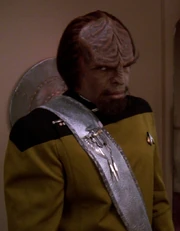
Worf wearing his dress uniform with a Klingon ceremonial sash
Dress uniforms were a variant of the standard Starfleet uniforms worn for special occasions, such as weddings , courts martial , funerals , and the greeting of ambassadorial delegations and heads of state. ( TOS : " Court Martial ", " Journey to Babel "; TNG : " Lonely Among Us ", " Manhunt ", " Data's Day "; DS9 : " Move Along Home ", " Rules of Engagement "; VOY : " Course: Oblivion ", " One Small Step ", " Ashes to Ashes "; Star Trek: Insurrection )
Appendices [ ]
Background information [ ].
Patrick Stewart 's character of Jean-Luc Picard has appeared in more styles of Starfleet uniform than any other character on screen without story contrivances (like time travel , holodecks , or alternate timelines ) being involved.
For most of Star Trek 's history, Starfleet uniforms have had at least three division colors. Some characters have worn different division colors in different episodes. Leslie , Jae , Tom Paris , Harry Kim , and Sylvia Tilly have each been shown wearing three colors at different points (including, for Paris and Kim, alternate timelines and holodeck scenarios); however, the first character to wear all three division colors in one episode was Ensign Sam Rutherford , who wore operations gold, command red, and medical blue in LD : " Envoys ".
The Starfleet uniforms worn during Star Trek: The Original Series were designed by William Ware Theiss , who returned to design the Star Trek: The Next Generation uniforms (which were further adapted into future versions on Star Trek: Deep Space Nine , Star Trek: Voyager , and the TNG -era films by Robert Blackman ). Robert Fletcher designed the uniforms seen throughout the original series movies, with later new designs provided by Nilo Rodis .
Robert Blackman also designed uniforms worn on Star Trek: Enterprise , a design representing a precursor to those seen in TOS . The uniforms seen in Star Trek: Discovery were designed by Gersha Phillips . The uniforms in Star Trek: Picard were designed by Christine Clark .
Michael Kaplan designed the uniforms seen in Star Trek and Star Trek Into Darkness , and Sanja Hays designed the uniforms for Star Trek Beyond .
As shown in the It's A Wrap! sale and auction , a number of Starfleet uniforms have had padding to increase muscular appearance. Such cases include two costumes for Tom Paris , one racquetball costume for Julian Bashir , and a Deep Space Nine costume for Worf, to create a more Klingon appearance. According to Wil Wheaton , all the main cast members wore muscle padding during the first two seasons of The Next Generation , mainly because of the tight-fitting nature of the spandex uniforms used in these two seasons. [2]
Several prototype uniform undershirts to those seen in Star Trek II: The Wrath of Khan on were sold off on the It's A Wrap! sale and auction on eBay. [3]
Ambiguous uniform [ ]
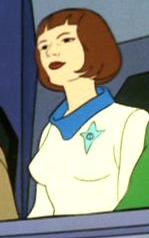
Female on the Elysian Council
A Human female seen as a member of the Elysian Council in " The Time Trap " wore a uniform of ambiguous origin. It was described in the Star Trek Concordance as "a white suit with blue collar and an insignia on the left breast," and was suggested to "possibly [be] an early Star Fleet [sic] uniform". While it is known that the Bonaventure , and possibly other Earth/Federation ships, were lost in the years prior to 2269, it is unclear if this is indeed a Starfleet uniform, and, if so, from which era it originated.
External links [ ]
- Starfleet uniform at Memory Beta , the wiki for licensed Star Trek works
- 22nd & 23rd century Starfleet uniforms at Ex Astris Scientia
- 24th century Starfleet uniforms at Ex Astris Scientia
- Starfleet uniforms at Spike's Star Trek Page
- Interview with William Ware Theiss at Phaser Resource (X)
Star Trek Shirt Colors Meanings – What Do The Colors On Your Star Trek Shirt Mean?
Last Updated on September 20, 2023 by Chase Reiner
In Star Trek, shirt colors signify crew roles. Gold: Command, Red: Operations, Blue: Sciences/Medical. Each color corresponds to specific duties and responsibilities within the starship’s crew hierarchy.

Jump To A Section
Star Trek Shirt Colors Meanings
Star Trek, the iconic science fiction series, has always had a unique system for distinguishing roles among its characters. Derived from naval traditions, this system involves different shirt colors for various positions. Here’s a breakdown on what each shirt colour signifies.
1. Gold: Command
The gold shirt, worn by Captain Kirk and other members of the Command division, signifies those in the highest positions of control. These individuals oversee the Starship operations and make essential decisions regarding their missions.
2. Blue: Sciences
The crew members in blue are generally in the Sciences division. This color is associated with characters like Spock and McCoy who are engaged in scientific inquiry, and medical duties, and are often responsible for finding solutions to complex problems.
3. Red: Operations and Security
Originally, the red shirt represented Engineering and Security personnel, frequently worn by Scotty or less frequently surviving away-team members. They are the backbone of the ship, managing technical operations, maintenance, and defense.
Following is a table summarizing the color codes and their meanings:
4. Green: Casual Wear
Though not a uniform color, Captains occasionally wore a green wraparound in a more relaxed, casual setting. This informal attire presents a different side of the otherwise stern figures in command.
5. White: Formal Wear
The white Starfleet dress uniform is reserved for formal events. It denotes prestige and respect, worn during diplomatic missions or significant ceremonies.
6. Black and Grey: Lower Ranks
In Star Trek: The Next Generation, outfits with black and grey tones were more typical for lower-ranking officers or those in civilian roles.
Star Trek’s uniform colors are more than just a piece of costume design; they communicate the diverse roles and responsibilities aboard the Starship. By understanding these color codes, viewers can identify the characters’ roles in the Starfleet and appreciate the complexity of the Star Trek Universe.
Why Did Kirk Wear Yellow In Star Trek?
One of the most popular stars trek shirt colors is yellow. This color signifies a member’s position in the sciences division and can be worn by scientists, doctors, or engineers.
The reason James T Kirk wore this specific star trek shirt was that he wanted his crew members to see him more than just their commanding officer; he wanted them to know they were working with each other for an important cause: exploration. He also loved wearing it because he knew how much command officers are usually seen on television shows like Star Trek.
Why Does Spock Wear Blue?
Spock wears blue because he is a member of the Science and Medical Division of Starfleet. In the Star Trek universe, Starfleet uniforms are color-coded to indicate which division the wearer belongs to:
- Gold: Command Division
- Blue: Science and Medical Division
- Red: Engineering and Operations Division
Spock is the Chief Science Officer of the USS Enterprise, so he wears a blue uniform. This is also consistent with his Vulcan heritage, as Vulcans are known for their scientific and intellectual pursuits.
In addition to its practical purpose, Spock’s blue uniform also serves as a symbol of his identity. He is both a Vulcan and a Starfleet officer, and his uniform reflects that. It is also a reminder of his commitment to science and the pursuit of knowledge.
In the early days of Star Trek, there was some confusion about why Spock wore blue. In the first episode of the original series, “The Cage,” Spock wore a gold uniform. However, this was quickly changed to blue in subsequent episodes.
According to Star Trek creator Gene Roddenberry, the reason for the change was to make Spock’s alien heritage more visually apparent. He also felt that the blue uniform was more fitting for Spock’s scientific role.
Whatever the reason, Spock’s blue uniform has become one of his most iconic features. It is a symbol of his intelligence, his dedication to duty, and his commitment to exploration and discovery.
What Do Star Trek Voyager Uniform Colors Mean?
The Voyager uniform color means the wearer is a member of the command division. In this star trek shirt, that person would be in charge of starship operations and shipboard functions such as security, engineering, or communications.
Why Does Wesley Wear Red?
The Wesley of Star Trek wears a red shirt , which means he is in the engineering division. He’s responsible for weapons systems and power distribution while also maintaining starship subsystems such as engines or communications networks.
Note: The colors listed above do not represent uniforms from any one specific era in Star Trek history; they can be considered generalizations assigned to different groups within Starfleet based on their function aboard starships and space stations. Furthermore, some non-Starfleet personnel wears these colors as well such as aliens working alongside Starfleet officers . These colors may also signify rank among both species that serve together under the United Federation of Planets banner (i.e., red – commander).
References:
https://www.themarysue.com/what-different-color-shirts-mean-star-trek/ https://screenrant.com/star-trek-uniform-colors-meaning-change-reason/

Hi, this is Chase Reiner from Idaho, USA. I am very passionate about fashion, My blog is all about exploring the latest fashion trends for men. I am a fashion lover and I love finding out what the hottest trends are and sharing all these in this MenNStuff.Com
Related Posts

Which Is The Best Looking Dress For Men? Tips For Men While Wearing Casual Dress.

What Color Shirt Go With Black Pant? Some Casual Outfits
Leave a comment cancel reply.
Your email address will not be published. Required fields are marked *
Save my name, email, and website in this browser for the next time I comment.
- More to Explore
- Series & Movies
Published Aug 23, 2023
The Starfleet Insignia Explained
No Star Trek symbol captures the eye or imagination quite like the delta.

StarTrek.com
"The Starfleet Symbol." "The Arrowhead." "The Delta."
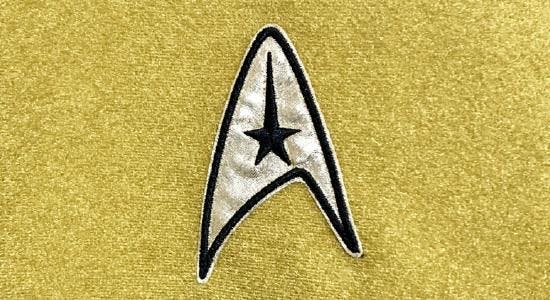
Star Trek uses symbols to convey a lot of things, but none captures the eye or imagination quite like the delta. In the years since The Original Series first aired, fans have tried to determine the meaning behind the various insignia shapes we see in the show. To most, it seems that the iconic delta shape is some sort of ship assignment patch meant to represent the U.S.S. Enterprise .
Some arrive at this conclusion because they see various Starfleet personnel wearing a number of different insignia. However, like any puzzle without a key, it’s impossible to precisely interpret the meaning of these other insignia.
The hidden key to the puzzle was finally uncovered a few years ago. The discovery was a memorandum written by producer Robert H. (Bob) Justman to costume designer William Ware (Bill) Theiss . The subject? STARSHIP EMBLEMS.
A copy of that memorandum has been digitized from the Gene Roddenberry Star Trek Television Series Collection (held in the Library Special Collections division of the Young Research Library at UCLA in Irvine, California) and is shown below:
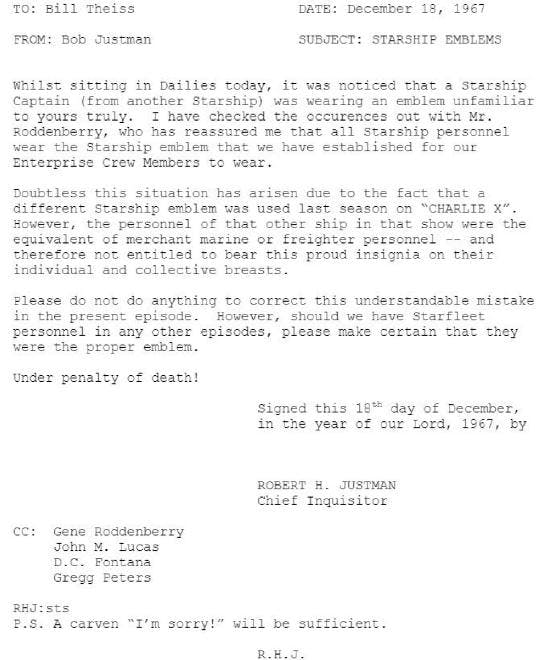
This memo, written during the production of the episode "The Omega Glory," and referencing Captain Ron Tracey, nullifies the long-held assumption that Starfleet assigned different insignia shapes to starships during TOS. Theiss’ inclusion of an alternate insignia for the Exeter 's captain and chief medical officer, unfortunately, downplays how genuinely ubiquitous the delta insignia is within the Star Trek universe. As a result, fans of the series are left with conflicting visual information regarding the meaning of the insignia worn throughout the original series.
Nearly 50 years after Bob Justman wrote his memo, we now have the opportunity to clarify the use of each and every Starfleet uniform insignia used in TOS. With a wee bit of Scotty's ingenuity, and a pinch of Vulcan logic, the complete picture of what Gene Roddenberry envisioned for the delta insignia should snap into focus.
There are six Starfleet duty insignia used in The Original Series:
- Starship Duty Insignia (Fleet personnel emblem)
- Spacecraft Duty Insignia (Auxiliary Fleet/ Merchant Marine personnel emblem)
- Outpost Duty Insignia (Outpost and Colony personnel emblem)
- Cadet Duty Insignia (Starfleet Academy student emblem)
- Starbase Duty Insignia (Headquarters, Space stations, Drydocks, and Ground installation personnel emblem)
- Fleet Command Insignia (Senior field commander personnel emblem)
In the Star Trek universe, the delta emblem is a direct descendant of the vector component of the old NASA (and later UESPA) logos in use during Earth’s space programs of the 20th and 21st Centuries. Those symbols were worn by some of the first space explorers and adorned uniforms and ships during humanity’s first steps into the final frontier.

United Earth Space Probe Agency integrated with Starfleet as the leading United Earth space exploration service.
The delta insignia was first drawn in 1964 by costume designer William Ware Theiss with input from series creator Gene Roddenberry. The delta — or “Arrowhead” as Bill Theiss called it — has evolved into a revered symbol and one that's synonymous with Star Trek today.
The delta also conveys information about the wearer’s duties aboard ship using a series of division symbols. When paired with a distinctive, elongated “star,” the insignia represents someone assigned to the Command division aboard ship. When it displays the “planet” symbol, it represents the Sciences division, a stylized “e” stands for Engineering (later Operations), and a red “Swiss Cross” is worn by starship personnel assigned to the Nursing Corps.
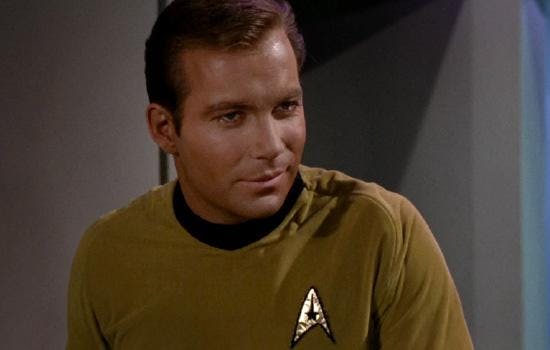
Captain James T. Kirk wearing the Starship Duty Insignia, Command Division.
Let’s continue our study of Star Trek ’s insignia with personnel assigned to other starships that are wearing the delta insignia.
Before we knew about this memo, we assumed that each ship had its own unique insignia, but there are problems that theory doesn't account for. For instance, does it bother you, or at least seem odd to see the surly guys in Starbase 11’s Officer's Club (in the episode "Court Martial") giving “their captain” a hard time over the presumed death of their mutual friend Ben Finney? Or, to see deceased crew members aboard the U.S.S. Defiant (in the episode "The Tholian Web") wearing the delta insignia?
If different starships had different symbols, why weren't they wearing them? Simple. The memo makes it clear that those Starfleet officers are not assigned to the Enterprise ; they are simply wearing Starfleet’s standard-issue Starship Duty Insignia.

Non-Enterprise Starfleet personnel in Starbase 11’s Officer’s Club in Court Martial, and Below: Deceased U.S.S. Defiant crew member wearing the Starship Duty Insignia in "The Tholian Web."
By now, you might be saying, “What about U.S.S. Exeter ’s Captain Ron Tracey and his chief surgeon, Dr. Carter?” As these two insignia patches are the error being addressed in the memo, they need no further explanation. They alone are the anomaly (an anomaly Theiss never repeated), which led to the misconception that every ship has its own assignment insignia.

Above: Captain Ron Tracey of the U.S.S. Exeter, and Below: his CMO, Dr. Carter.
As you can see here, Theiss thoughtfully, if erroneously, provided both officers with unique assignment insignia patches, and in keeping with his fastidious reputation, insured both patches included their appropriate division symbols.
Early in TOS, we get our first look at non-delta insignia. In the episode "Charlie X," Antares ’ Captain Rampart and his first officer are wearing the Spacecraft Duty Insignia, which indicates that they are assigned to an auxiliary spacecraft serving in Starfleet's Merchant Marine Corps — just as Justman points out in his memo.
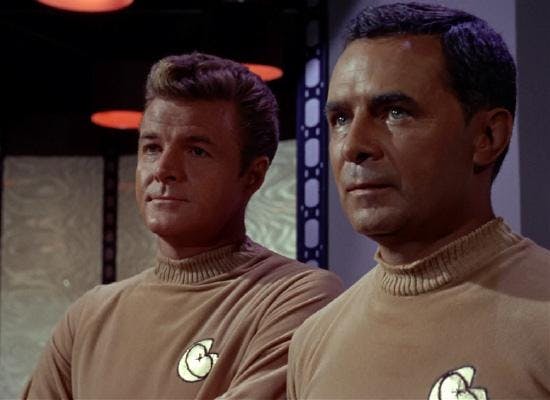
Antares' Captain Rampart, and his XO wearing the Merchant Marine Spacecraft Duty Insignia.
Not long after that, we get a look at another new insignia. The Outpost Duty Insignia is worn by Starfleet personnel assigned to outposts on the very edge of Federation space, the frontier. This emblem is characterized by a gold spikelet against a black background. Warning: Do not put yourself in a situation where this insignia goes on your uniform. Personnel wearing this badge never seem to live happily ever after.

Outpost Crew from "Balance of Terror" & "Arena" pictured wearing the Outpost Duty Insignia.
A few episodes later, the Enterprise takes shore leave and Kirk reminisces about his days at the Academy. Worn by students attending Starfleet Academy, the Cadet Duty Insignia is characterized by a pewter colored, smaller version of the Starbase Duty Insignia.
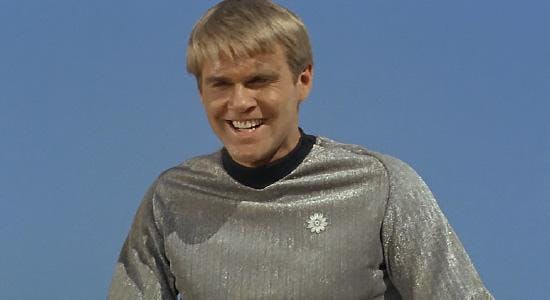
Second Class Midshipman Finnegan wearing the Cadet Duty Insignia.
First seen in "The Menagerie," the Starbase Duty Insignia is worn by personnel assigned to Federation Starbases, which include Starfleet Headquarters, space stations, drydocks, and other ground installations. The emblem, which is devoid of any departmental symbol, is a stylized representation of an “Evening Starflower” (a flowering plant native to the western hemisphere of Earth).
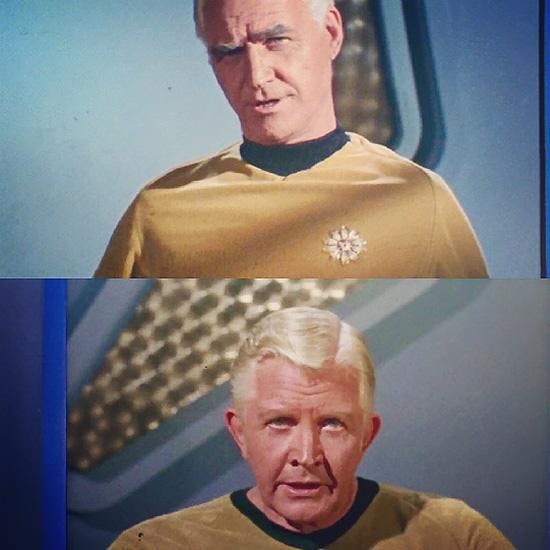
Above: Admiral James Komack of Starfleet Command - Sector 9, and Below: Admiral Fitzpatrick.
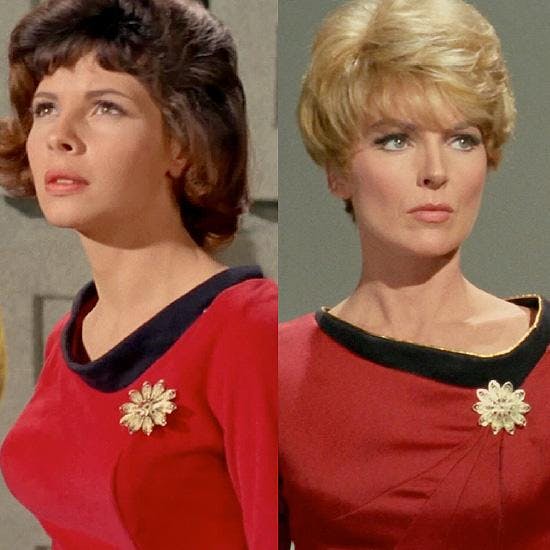
Miss Piper, assistant to Commodore Mendez, and Lt. Areel Shaw Starbase 11 JAG Officer wearing the Starbase Duty Insignia.
So how does Commodore Wesley in "The Ultimate Computer," or Commodore Decker in "The Doomsday Machine," fit into the spectrum of Starfleet insignia?
Well, let’s talk about commodores for a moment. A commodore is a flag officer rank, one position above captain. A starship captain usually commands a single vessel, but a commodore ordinarily commands more than one ship. Usually, commodores command a group of ships (either close to their flagship or distant), or in the case of TOS, they normally command a starbase.
In charge of evaluating the operational performance of the M5 computer while it's in total control of a starship, Commodore Wesley sits in temporary command of the U.S.S. Lexington to lead a battle fleet in war games against the Enterprise . Throughout the episode, Commodore Wesley continues to wear his Starbase Duty Insignia, while the Lexington crew would have been wearing the delta.
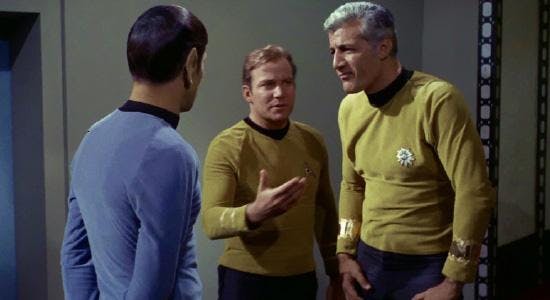
Commodore Bob Wesley in the transporter room briefing Captain Kirk and Mr. Spock about the M5 computer.
Finally, we come to one of my favorite characters ever — Commodore Matt Decker in "The Doomsday Machine." We saved him for last because we could only properly discuss his insignia and what it means after we talked about Starfleet’s other symbols first.
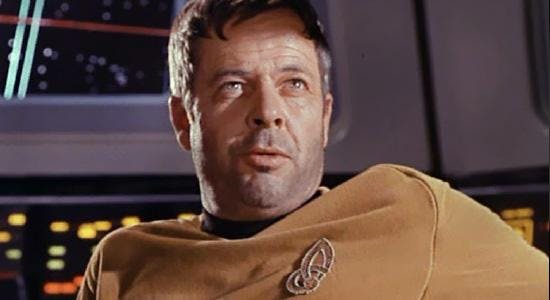
William Windom as Commodore Matt Decker
Unlike Commodore Bob Wesley, who was only in temporary command of the Lexington , Matt Decker is a Flag Officer with permanent field command of a starship. In fact, he's the only Flag Officer we see in Star Trek with a field command. As a consequence of Commodore Decker's rank and status as Commander of the U.S.S. Constellation (his flagship), he wears the Fleet Command Insignia denoting his status as a Flag Officer in the field. If we had seen Commodore Decker's crew (may they rest in peace), we would have seen the delta shape insignia in use on their uniforms. Commodore Decker's own first officer would have held the rank of Captain and worn the Starship Duty Insignia.
It should be noted that "The Doomsday Machine," which was filmed early in Season 2, is not referenced in Bob Justman’s memo. Some speculate that Decker’s absence from the memo is further indication of the inconsistent use of emblems in Star Trek , but that presupposes that the production staff missed that detail. However, the very existence of the Justman memo, and a whole forest of others just like it, demonstrates that the opposite is true.
The production team of Star Trek worked diligently to ensure that every aspect of the future they were busy creating held up under scrutiny. Gene Roddenberry was notoriously rewriting scripts himself to ensure no less than exactly what he wanted ended up on-screen, and that fastidious nature permeated the entire production staff. That Decker’s unique emblem is not mentioned in the production memo indicates that his particular insignia isn't an error at all; but represents something else.
Check out Commodore Decker's insignia. Remember that when Theiss created the insignia for Captain Ron Tracey, he went out of his way to ensure it was emblazoned with a Command Star department symbol. Commodore Decker has no such departmental symbol in his insignia patch, which places it in the same design lineage as the Starbase Duty Insignia, which is also devoid of any departmental symbol.
At this point in Star Trek , we’ve seen a number of flag officers; but they have all worn the Starflower shape, which indicates assignment to a starbase, while Matt Decker alone in TOS series serves as a flag officer in permanent command of a starship. He is wearing an insignia that conveys his unique status, the Fleet Command Insignia, and if you look closely, you'll see that Matt Decker’s emblem is visually related to the Starbase Duty Insignia. Decker’s insignia is a stylized representation of an individual petal from the same “Evening Starflower” emblem that comprises the starbase symbol. This insignia isn't mentioned in the production memo because it's not an error at all.
Hopefully, by now, you can see how consistent the Star Trek costume department really was in their use of insignia, and that Bill Thiess never repeated the error he made during "The Omega Glory" after it was pointed out by the memo.
Returning to the delta, Roddenberry and Justman intended it to be a very special symbol that communicates something important. The insignia worn on Starfleet uniforms is the equivalent of the badges worn by U.S. Service members — to show how they serve, not where they serve. Both men served with distinction in World War II. Roddenberry was an Army Air Corps pilot and Justman was a radio operator in the Navy. In the air and at sea, they understood the value of visual communication. In uniform, they themselves carried those values on their chests, on their collars, and on their sleeves. Twenty years after they wore their own various insignia, they helped to create something new — a symbol to inspire others. In the 1960s, the Starfleet delta had far more in common with the golden pin awarded to a NASA astronaut than a simple mission patch, and it was intended to equal that proud emblem in both use and sentiment.
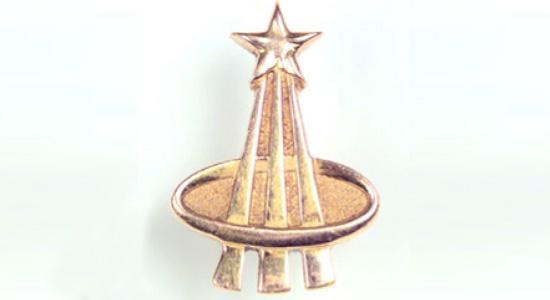
The NASA Astronaut Pin. There are two versions of this pin, a silver pin awarded to those who complete their training, and a gold pin awarded only to astronauts who have flown in space.
The delta proclaims that the person wearing it has achieved the goal of every cadet entering the Academy, and the dream of many a devoted fan — to serve aboard a starship and set sail in an endless sea of stars.
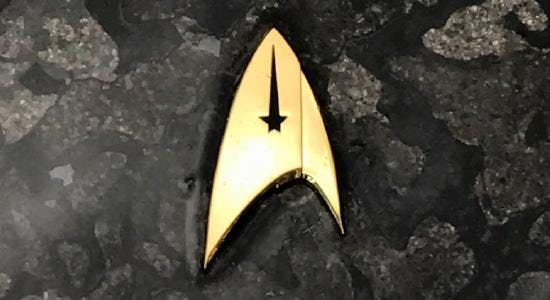
Starfleet Insignia Badge, Command Division from Star Trek Discovery
They used to say if man could fly, he'd have wings. But he did fly. He discovered he had to.
Captain James T. Kirk
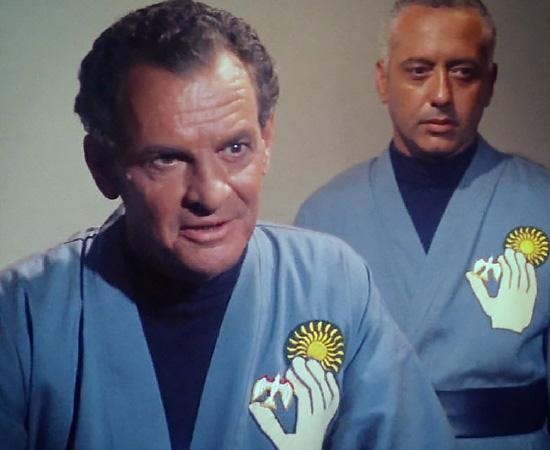
I am grateful to have an experienced and learned group of expert Star Trek fans who helped with the research on this article — Steve Fronczek, Creative Services Manager, ANOVOS; Lieutenant Commander Michael J. Quigley, United States Navy; and Dayton Ward, Star Trek author.
Get Updates By Email
This article was originally published on October 7, 2018
John Cooley is a lifelong Star Trek fan.
- Behind The Scenes
- Star Trek 101

Why This Redshirt Was Fine and the Redshirt Myth Is a Lie
Redshirts have come along way since the original Star Trek. But they were never really what people claimed, thanks in part to one prominent character.
The infamous redshirts -- doomed to die solely because of their uniform color -- have long been an indescribably essential part of Star Trek culture. What started as a joke turned into a celebration to the point where an entire series -- Star Trek: Lower Decks -- centers around them. The concept isn't going anywhere, and by now, red shirts become a part of the fun.
But while the joke remains an essential part of Star Trek culture, its basis in reality is much less clear. Indeed, one of the most celebrated characters in the franchise -- Montgomery Scott -- is himself a redshirt. He and his lesser-known compatriots have far more muddled beginnings than modern Star Trek fans may think.
RELATED: Star Trek Theory: Why the Borg Queen Didn't Appear in The Next Generation
Redshirt Jokes Arose From a Natural Assumption
Star Trek 's tricolors denote the wearer's department onboard ship. In The Original Series , red meant someone from either engineering or security. (Lt. Uhura, who ran communications, was technically part of the engineering department.) It made sense, therefore, for more security crewmen to die than any other department, since they put themselves in harm's way the most often. Accordingly, any character who suddenly appeared on the show with no previous screen time was bound to be killed by the first commercial break and invariably wore a red shirt.
The series took a little time to reach that point, however. The first official redshirt -- that is, the first disposable crew member who existed more or less to be killed by the threat du jour -- was Crewman Darnell in Season 1, Episode 5, "The Man Trap." He wore medical blue rather than red. In fact, of the 15 "disposable" crew members in the first season, only four wore the red shirts.
That changed in the second season, as the writers' realized that security teams were more likely to be killed. Twenty-two redshirts died in Seasons 2 and 3 of The Original Series , as compared to 14 combined for blue and gold uniforms. Fans took notice, and the show did itself no favors with its sometimes obvious signaling. If a previously unknown crew member beamed down with the regular cast, it wasn't hard to guess what would happen. Eventually, it became a joke, though quite a beloved one.
Scotty and Uhura Both Defied the Redshirt Trope
Yet amid all of that, Scotty remained a series stalwart. He appeared in 65 of the show's 79 episodes and often took command of the ship when Kirk and Spock beamed down to the planet's surface. His very presence ran against the redshirt premise. Star Trek: Strange New Worlds picked up on the notion and ran with it when it introduced a much younger Montgomery Scott in Season 2, Episode 10, "Hegemony." He was presented essentially as a redshirt: a random crewman rescued on a planet overrun with hostile aliens. Yet while the episode ended on a cliffhanger -- with its resolution uncertain as of this writing -- canon demands that he will survive.
Similarly, women redshirts almost always lived to see the final credits: most notably Lt. Uhura, but also Janice Rand and a bevy of supporting characters. The big exception was Leslie Thompson in Season 2, Episode 22, "By Any Other Name," who got turned into a desiccated cube and crushed in the first act. She was a notable rarity, however, and while the tendency arose largely from patriarchal tropes, it also blunted the notion that wearing red automatically constituted a death threat.
RELATED: Star Trek Theory: The Final Frontier's Villain Could Be This Powerful Alien Species
Star Trek Has Always Pushed Back Against Redshirt Jokes
As the redshirt notion gained traction among the fan base, Star Trek began to push back. Here, too, Scotty stepped up in defense of his fellows, most notably in Star Trek II: The Wrath of Khan . The film depicted a cadet in the engineering department who gets killed in Khan's first attack on the Enterprise . Cut scenes developed his story further: he was Scotty's nephew. It explained the chief engineer's grief, but also hammered home the point that even the canon fodder had people who loved them. He arrived alongside the Star Trek movies' switch to "the monster maroon" uniforms, effectively making every crew member (or at least the officers) a redshirt.
Star Trek: The Next Generation went a step further when bringing back the traditional tricolor uniforms from The Original Series , with a twist. This time, the command officers wore red, while security wore yellow: neatly reversing the previous configuration and removing the visual stigma. Among its other benefits, it made a pointed statement about the disposability of redshirts. If Captain Picard and Commander Riker wore red, it couldn't possibly be a death sentence.
Even so, the redshirt notion kept cropping up in canon, though admittedly, it became much more playful and self-referential. For instance, the doomed Lt. Hawk in Star Trek: First Contact was a redshirt, which gained prominence as actor Neal McDonough went on to a high-profile career. 2009's Star Trek movie made a far sharper dig when the previously unknown Chief Engineer Olson joined Kirk and Sulu on a dangerous mission. Naturally, he didn't survive, leaving the door open -- once again -- for Scotty to stop in.
Two Versions of Lower Decks Made Redshirts the Heroes at Last
The first semi-official "redshirts" story arrived with The Next Generation Season 7, Episode 15, "Lower Decks." The main crew faded into the background for the episode, replaced by a quartet of young officers working far less glamorous posts in the bowels of the Enterprise-D . Though it took itself far more seriously than the later animated series -- it ended with the death of one of its central characters -- "Lower Decks" firmly established that even the background characters on a starship have stories to tell.
That, in turn, resulted in Lower Decks : a full-bore satire that nevertheless strove to honor Starfleets' forgotten underlings. Ensigns Boimler and Mariner both wore red, ostensibly because they're in command division, but implicitly because they're the kind of characters who stood a very good chance of being killed back in The Original Series . Instead, they're the ones saving the day: usually in a thoroughly ridiculous manner and often without credit from their (equally ridiculous) bridge crew. The show finally found the sweet spot where the redshirt concept to call home.
But the idea was never the joke it was sometimes made out to be, and while Star Trek learned to laugh at them , they always held redshirts in surprisingly high regard. The rise of the concept had some very clear rationale, but it was never the instant in-joke it sometimes appeared to be. Scotty had a great deal to do with that, and his response -- like the notion itself -- evolved along with the franchise. Small wonder it all became an ingrained part of Star Trek 's fabric.

Sophia Bush Comes Out, Responds to Accusations She's a Homewrecker, Reveals How Ashlyn Harris Relationship Started & Why Grant Hughes Marriage Ended
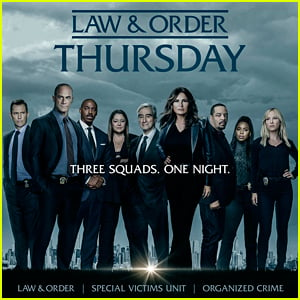
Fate of Every 'Law & Order' TV Show Revealed, & There's a Big Change Coming

3 Big Stars Join the Cast of 'Heartstopper' Season 3!

Amanda Seales Addresses Alleged Issa Rae Feud
Chris Pine Wears Signature Short Shorts to 'Poolman' Premiere, Recalls Being 'Terrified' on First Red Carpet

Chris Pine is bringing his signature look to the red carpet!
The 43-year-old actor attended the Los Angeles premiere of his directorial debut Poolman on Wednesday (April 24) at the Vista Theatre.
He made a fashionable statement by wearing a pair of short shorts for the big occasion.
While on the red carpet, Chris also reflected on his first big premiere for Princess Diaries 2 back in 2004. He described the experience as terrifying and spilled some details about the memorable moment.
Keep reading to find out more…
“I remember when we had to do the premiere for that, it was at Disneyland. I got picked up in a stretch limo with my agent and we went there and I was so nervous,” he recalled in an interview with ET at the Poolman premiere.
He continued, saying, “I mean, I remember wearing Converse and grey pants and just being absolutely terrified.”
Why? “Just because this whole experience and people shouting… you’ve got to get used to that whole thing,” he explained.
Nearly twenty years later, Chris is very clearly at home on the red carpet. He paired blue shorts with a pair of boots and a peach blazer. The actor finished the look with an “I [heart] LA” t-shirt, sunglasses and a large floral brooch.
He wore his hair in loose waves and rocked some scruff.
While he’s proven that he can dress up , the actor has become known for his love of shorts .
For this occasion, he got support from Star Trek costar John Cho !
The star has even addressed how long he plans to keep on wearing leg-baring shorts .
Poolman arrives in theaters on May 10. Check out the trailer !
Scroll through all of the photos of Chris Pine in the gallery…

JJ: Latest Posts
- Louis Tomlinson Releases Surprise...
- Tyler Hynes, Andrew Walker, & Paul...
- 2 'Law & Order' TV Shows Renewed,...
- RuPaul's DragCon LA 2024 - Details...
- 'The Equalizer' Renewed for Season 5...
- Amanda Seales Addresses Alleged Issa...
- 'Survivor' 2024: Top 8 Contestants...
- Bella Ramsey, Louis Partridge &...
- 'Selling the OC' Cast Changes: Three...
- Lucy Hale, Lana Condor & Lena...
- 3 Big Stars Join the Cast of...
- Harvey Weinstein's 2020 Rape...
- Sophia Bush Responds to Accusations...
- Lana Del Rey's Coachella Set Ends With...
Just Jared Jr.
- 'Pretty Little Liars: Summer School'...
- 'Kickin' It' Cast Reunite In New Photo...
- Paramount+ Renews New 'Dora'...
- Milo Manheim Talks Getting His Start...
- Iain Armitage Reflects On First Day of...
- Ariana Greenblatt Joins the Cast of...
- Kit Connor to Make Broadway Debut in...
- © 2005-2024 Just Jared, Inc. ||
- Accessibility
- Privacy Policy
- Manage Cookies
- Return to Mobile

Changelings In Star Trek: Discovery - Did Season 1 Burnham Know About DS9's Villains?
WARNING: This article contains SPOILERS for Star Trek: Discovery season 5, episode 4, "Face the Strange" Mutineer Michael Burnham (Sonequa Martin-Green) calls her future self a "shapeshifter" during Star Trek: Discovery season 5, episode 4, but does this mean that she's aware of Star Trek: Deep Space Nine 's Changeling villains? In Discovery season 5, episode 4, "Face the Strange", Burnham, Commander Rayner (Callum Keith Rennie) and Commander Paul Stamets (Anthony Rapp) are thrown backwards and forwards in time by a Krenim time bug. To return to the 32nd century, Burnham is forced to fight her younger self, who believes that she's a shapeshifting infiltrator determined to sabotage the USS Discovery .
Star Trek: Discovery season 5, episode 4, "Face the Strange" was written by Sean Cochran and directed by Lee Rose.
Changeling infiltrators caused many problems for Captain Benjamin Sisko (Avery Brooks) and the crew of Deep Space Nine during the Dominion War. However, DS9 's conflict with the Dominion and its Changeling Founders took place a century after the climactic scenes of Discovery season 5, episode 4 , during which the Federation was at war with the Klingon Empire. This makes it unlikely, but not impossible, for the season 1 version of Michael Burnham to be referring to one of DS9 's Changelings in Star Trek: Discovery .
Every Changeling In DS9 (Besides Odo)
Season 1 burnham probably isn't referring to ds9's changelings in discovery.
Official First Contact with the Changelings didn't take place until the 24th century , in Star Trek: Deep Space Nine 's two-part season 3 premiere "The Search". This means that it's unlikely that Season 1 Burnham wasn't referring to a DS9 Changeling while trying to foil Season 5 Burnham, Rayner, and Stamets' "sabotage" in Star Trek: Discovery . However, DS9 established that the Changelings had been exploring the galaxy for eons before the 24th century . This creates the outside chance that the season 1 version of Burnham had encountered one of DS9 's Changelings prior to joining the USS Discovery.
The Female Changeling, the species' spokesperson, was played by Salome Jens, who also played the Progenitor in Star Trek: The Next Generation 's "The Chase", to which Star Trek: Discovery season 5 is a sequel.
Constable Odo (Rene Auberjonois) was one of 100 Changelings that were sent out into the galaxy, " centuries ago ". Odo only ever met one of the hundred Changelings, Laas (J.G. Hertzler), who arrived on the planet Varala in the 22nd century, 100 years before Star Trek: Discovery's timeline begins. Odo made it further than Laas, arriving in the Alpha Quadrant, where he was discovered by Bajoran scientists. It's possible, therefore, that other members of the Hundred Changelings were encountered by Burnham while she served aboard the USS Shenzhou. Alternatively, Burnham was referring to one of the many Star Trek shapeshifters that aren't Changelings .
Star Trek Shapeshifters That Aren't Changelings
Star Trek: Deep Space Nine 's Changelings are just one of many aliens that have the ability to change their shape to imitate other forms . One of the most memorable shape-shifting alien species in the Star Trek canon was the Chameleoid, Marcia (Iman), who both kissed and impersonated Captain James T. Kirk (William Shatner) in Star Trek VI: The Undiscovered Country . Another shape-shifting alien with romantic intentions was Species 8472 from Star Trek: Voyager , one of whom impersonated Valerie Archer (Kate Vernon) and romanced Commander Chakotay (Robert Beltran).
Shape-shifting could even be taught, as seen in the Star Trek: The Original Series episode "Whom Gods Destroy" , in which Garth of Izar (Steve Ihnat) showed off the abilities he learned from the Antos natives. The Traveler from Star Trek: The Next Generation also had shapeshifting abilities, impersonating Wesley Crusher's father Jack in "Journey's End". Some members of Star Trek: Enterprise 's Suliban species had technology that enabled them to shape-shift, enabling them to infiltrate various situations. With so many shapeshifters in the Star Trek universe, it's no wonder that Burnham was so paranoid in Star Trek: Discovery season 5, episode 4.
Star Trek: Discovery streams Thursdays on Paramount+.
Star Trek: Discovery
Star Trek: Discovery is an entry in the legendary Sci-Fi franchise, set ten years before the original Star Trek series events. The show centers around Commander Michael Burnham, assigned to the USS Discovery, where the crew attempts to prevent a Klingon war while traveling through the vast reaches of space.
Star Trek: Deep Space Nine
Star Trek: Deep Space Nine, also known as DS9, is the fourth series in the long-running Sci-Fi franchise, Star Trek. DS9 was created by Rick Berman and Michael Piller, and stars Avery Brooks, René Auberjonois, Terry Farrell, and Cirroc Lofton. This particular series follows a group of individuals in a space station near a planet called Bajor.
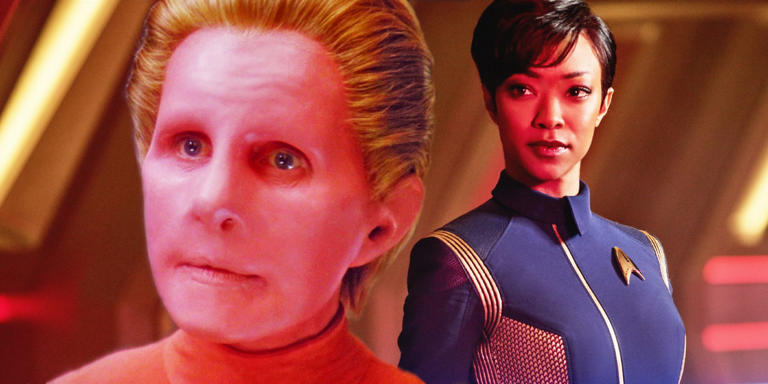

IMAGES
VIDEO
COMMENTS
TNG. Deep Space Nine Voyager Discovery Picard Below Decks. TNG. Deep Space Nine Voyager. Learn more. The meaning of their uniform shirts eluded me for the longest time. But apparently, there is a ...
But it's the different colors of the Starfleet uniforms that really tell the story of how the Enterprise operates. Fans know the basics: an array of blue, red, and gold shirts line the bridge of ...
For a period of time, the term "red shirt" became a dirty word in the "Star Trek" world; it's gone on to take on a larger cultural significance, indicating that a person is a disposable background ...
The meaning of gold, red and blue have changed over the years and so too has the way that those colors are displayed on the uniform. This is understandable for a franchise that has been running for 57 years. Each new costume designer will have their own vision for how they think Star Trek 's uniforms will look, and which characters would best ...
Commanding Officers of Star Trek Image: Paramount. The classic shirt color of those in command positions is gold. Unless we're talking about Captain Kirk's green formal top in the "Journey to Babel" episode of The Original Series. (Captains Pike and Kirk revive these prime colors in Strange New Worlds.)Then Captain Picard came along in The Next Generation and the colors shifted to red ...
Star Trek uniforms are costumes worn by actors portraying personnel of a fictitious Starfleet in various television series and films in the Star Trek science fiction franchise. During the various series, the costume design has often changed to represent different time periods and for reasons of appearance and comfort. Sometimes different styles were deliberately mixed to enhance the sense of ...
In Star Trek: The Original Series, which ran from 1966 to 1969, you can't miss the brightly hued uniform shirts sported by the crew of the starship Enterprise.Captain James T. Kirk and other members of the command staff sport golden yellow tops, says Mental Floss.Blue is reserved for the science department and medical personnel, so you'll see it on Mr. Spock, the second-in-command, and the ...
Blue shades indicate ship medics and scientific personnel. Gold Uniforms: Worn by command officers, gold symbolizes the importance of strategic decisions. Command staff, including Captain Kirk, would wear these iconic golden shirts. TNG, DS9 & Voyager. In Star Trek: The Next Generation (TNG), and beyond, not only did the uniforms modernize, the ...
The original crew in their tri-color uniforms. In the original Star Trek series, which ran from 1966-1969 (or roughly from 2254 to 2269, in universe), there were three standard uniform colors ...
Star Trek's uniforms have evolved throughout the decades over the course of the franchise.; The meanings behind the colors have shifted throughout the Star Trek eras, but most series generally stick to the tri-color format.; Each new Star Trek series has brought its own unique take on the main crew's uniforms while still providing visual connections between the eras.
Gold was also reserved for just the captain on board the ship, rather than those in command positions. This explains why Kirk wore gold, and Spock, his second in command, did not. Yellow/gold then ...
The TOS uniforms are arguable the most recognized and iconic of uniforms in the canon. They are the blueprint for all other uniforms in Star Trek.While they carry some of the elements from the "The Cage" unaired pilot episode — tunic-like top, Section colors, black capri-length trousers and boots — the cut and fit of the garments are narrower, the colors much sharper and for the women ...
Star Trek's Different Uniform Colors And Their Meanings Explained. The Starfleet uniforms seen on the original "Star Trek" series back in 1966 were designed by William Ware Theiss, a costume ...
When the original Star Trek series premiered in 1966, it wasn't just the groundbreaking storytelling that caught the audience's attention; it was also the iconic uniforms worn by the crew. The most striking feature is the bright color scheme. The uniform colors were used to help viewers instantly recognize the roles of the crew.
Here's a quick breakdown on the Star Trek uniform colors from the Original Series: The command division wore gold shirts. This includes Captain Kirk, Lieutenant Sulu, and Pavel Chekov. The science and medical staff wore blue shirts. This includes Lieutenant Commander McCoy and Commander Spock. The engineering and communications division wore ...
Star Trek uniform colors explained. The basic colors that outline Star Trek as a whole are an array of blue, red and gold. These colors line the bridge of the ship in every episode, and relate specifically to the various occupational roles that are performed on the ship. Each member wears the color that corresponds with that specific class or ...
The Original Series three uniform colors. The Original Series. blown up plunge head-first surgically removed 26 officers The Apple. Strange New Worlds The Original Series The Original Series. Star ...
For most of Star Trek's history, Starfleet uniforms have had at least three division colors.Some characters have worn different division colors in different episodes. Leslie, Jae, Tom Paris, Harry Kim, and Sylvia Tilly have each been shown wearing three colors at different points (including, for Paris and Kim, alternate timelines and holodeck scenarios); however, the first character to wear ...
Blue still means the wearer is in the sciences. The color distinctions are less pronounced than they were in Star Trek: The Original Series. Command red is a muted burgundy, gold is a mustard tone, blue is actually teal. The uniforms are primarily black, the contrasting color changes were instigated by the guys who previously wore red shirts.
Star Trek Shirt Colors Meanings. Star Trek, the iconic science fiction series, has always had a unique system for distinguishing roles among its characters. Derived from naval traditions, this system involves different shirt colors for various positions. Here's a breakdown on what each shirt colour signifies.
Star Trek uses symbols to convey a lot of things, but none captures the eye or imagination quite like the delta. In the years since The Original Series first aired, fans have tried to determine the meaning behind the various insignia shapes we see in the show. To most, it seems that the iconic delta shape is some sort of ship assignment patch meant to represent the U.S.S. Enterprise.
The infamous redshirts -- doomed to die solely because of their uniform color -- have long been an indescribably essential part of Star Trek culture. What started as a joke turned into a celebration to the point where an entire series -- Star Trek: Lower Decks -- centers around them. The concept isn't going anywhere, and by now, red shirts ...
An analysis of the classic Star Trek series showed that out of the 59 crew members who died in episodes of the series, 43 (or 73%) wore a red shirt. In the novel Killing Time, published by Pocket Books in 1985, a crew member states: "You don't want to wear a red jersey while on the landing party.". In the book Legends of the Ferengi ...
For this occasion, he got support from Star Trek costar John Cho! The star has even addressed how long he plans to keep on wearing leg-baring shorts . Poolman arrives in theaters on May 10.
Official First Contact with the Changelings didn't take place until the 24th century, in Star Trek: Deep Space Nine's two-part season 3 premiere "The Search".This means that it's unlikely that ...